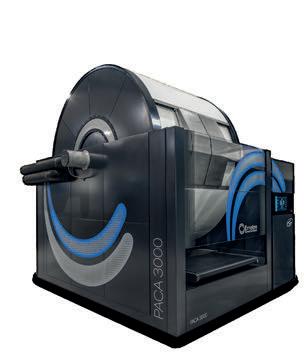

From one tree grows a thousand possibilities

Södra is to add tannin to its range of forestbased products and seeks partners to develop new tannin-based sustainable alternatives to fossil products in a range of applications.
Södra is investing in a production line at its Värö facility in Sweden, which will create a vegetable tanning agent from bark. This new tannin can be used to process leather in a more environmentally friendly way. The line will have the capacity to produce tannin for millions of square metres of leather.
“Now is the time to unite and maximise the potential of every tree, exploring innovative applications for tannin collaboratively. Together, we can develop fossil-free products and contribute to a more sustainable future," said Viktor Odenbrink, Sales Director, Södra Bioproducts.
Are you one of our potential partners? Contact us here:
Viktor Odenbrink Sales Director, Södra Bioproducts viktor.odenbrink@sodra.com
sodra.com
This is Södra
Södra is the largest forest-owner association in Sweden and an international forest industry group. With raw material from the sustainably managed forests of more than 50,000 forest owners, Södra produces timber products, pulp, energy and bioproducts, such as biochemicals – and is always looking to develop new products from trees.
News
2 News map News highlights from around the global leather industry.
4 Industry & Innovation New technology, new ideas from leather industry suppliers and service providers.
6 Leatherscene People from around the industry and famous lovers of leather who have made the headlines in recent weeks.
8 Backtrack Headlines from www.leatherbiz.com, the industry’s best and most complete news website. Leatherbiz is now in its 25th year. You can read about almost everything that has happened in the global leather industry this century on leatherbiz. No other news archive comes close.
Leather Leaders
10 Perfect fit The future is the circular economy, the secretary general of COTANCE, Gustavo González-Quijano, says. He is working to make clear that leather is the perfect material for that future.
Special Report
14 APLF 2025 The forty-first edition of APLF took place in Hong Kong in March. Our review suggests the mood at the show reflected the current caution within the global leather industry, but there were still 600 exhibitors from 40 different countries present, and plenty of lively discussion.
Technology
19 Power play Commitment to renewable energy is one of the reasons leather chemicals group GSC has invested in a new facility in Montebello Vicentino. It will cover 12,000square-metres, around one-third of which will have solar panels installed.
22 Carbon synch Chief executive of the Ars Tinctoria leather laboratory, Gustavo Defeo, outlines his reasons for optimism that the European technical committee responsible for standardisation for bio-based products will ensure transparency, reliability, and consistency.
24 Reverse psychology The Greenstar roller-coater is designed as an advanced solution for the reverse finishing of whole hides and bovine sides, as manufacturer Gemata explains.
Leather and the Circular Economy
26 Thought Leadership: Trust fund Campaign group WWF has launched a new $10 million fund to help remove links to deforestation from the leather supply chain.
30 Thought Leadership: Data burden Tiny companies in Italy’s footwear manufacturing industry are bearing an unfair share of the weight when it comes to satisfying sustainability regulations.
32 Circular Stories: What liberation? Huge increases in the tariffs the US is imposing on its partners are putting the global trading framework for raw materials at risk. Who could have imagined that hides could be too renewable for their own good?
38 Circular Stories: Bad news for finished goods Cars, bags and shoes are among the finished product categories that are caught up in the chaos unleashed by April’s tariff turmoil.
42 Circular Stories: Fooled by fast fashion An unwillingness on the part of other contributors to see the importance of leather’s longevity and repairability has led COTANCE to withdraw from a group working to establish category rules for calculating the environmental impact of footwear.
44 Essential reading
IBC Advertisers’ index
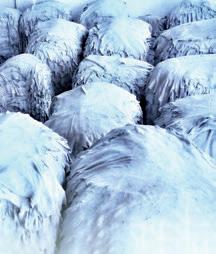
Cover image: Wet blue hides. Hides have to go to where the tanning drums turn, but shipments of US wet blue to tanners in China have suddenly more than doubled in price.
CREDIT: SHUTTERSTOCK/AFROZEE

World Leather iPad edition
The world’s best leather industry magazine is now available to download on iPad from www.leatherbiz.com
@WTPworldleather
@WTPworldleather
linkedin.com/showcase/wtpworldleather
@WTPworldleather
World Trades Publishing Ltd 2025. Contributions: The editor welcomes news items, articles and photographs for consideration and possible publication but no responsibility can be accepted for the loss or non-publication of such material. Opinions expressed by individual contributors do not necessarily reflect the view of the editor or publisher.
• Whilst every effort is made to ensure accuracy in reproduction, no responsibility can be accepted for the technical content or for claims made by manufacturers for product performance that are published. Publication in World Leather cannot be construed as an endorsement for a claim or product by the publisher.
• World Leather is published 6 times per year by World Trades Publishing, The Old Stone House, Teeton, Northampton NN6 8LH UK. Price UK £90, ROW: £150 per year (six issues).
Graphic origination by WTP. Print by Bishops Printers, Walton Road, Portsmouth, Hampshire PO6 1TR, England. All rights reserved. ISSN 0894-3087
The World Leather team has been publishing a series of original, dynamic podcasts since 2019. The whole series is available on Anchor, Spotify, Apple Podcasts, Google Podcasts, Pocket Casts, Overcast and other podcasting platforms. Just search for the World Leather Podcast on the platform you prefer.
World Trades Publishing 2025: All rights reserved. No part of this publication may be reproduced, stored in a retrieval system or transmitted in any form or by any means mechanical, electronic, recording, photocopying or otherwise, without the written permission of the publisher. World Leather®, Tannery of the Year® and Nothing to Hide® are registered trademarks
The World of News
EUROPEAN UNION The official statistics office of the European Union, Eurostat, has published figures that put the European Union’s cattle population at the start of this year at 72.2 million head. It said this figure was down by 2.3% from the total at the start of the previous year, meaning the 27-state European Union lost 1.7 million head of cattle in the course of 2024. Commentators have pointed out that dry conditions in many parts of Europe over a prolonged period in 2022 and 2023 is one of the main factors in cattle herds reducing in size.
SPAIN Spanish double-face and nappa producer Inpelsa has won court approval to take over the tannery that Tenerías Omega ran in Navarra in northern Spain until last year. Valencia-based Inpelsa is run by current COTANCE president, Manuel Ríos Navarro. It will relaunch the Tenerías Omega business as Inpelsa Calf. As part of the deal, Inpelsa will take on 44 of the 79 employees that Tenerías Omega had when it closed down in September.
HUNGARY The country has deployed soldiers and introduced new disinfection measures to contain an outbreak of foot-and-mouth disease in its north western region bordering Slovakia and Austria, as reported by Reuters. The country’s first case in over 50 years was detected on a cattle farm in March and has since spread to two more farms in Gyor-Moson-Sopron county, affecting 3,500 cattle. Neighbouring Slovakia has also reported outbreaks at five locations and stepped up containment efforts.
ITALY The ‘Amici per la Pelle’ exhibition has begun a tour of schools in Italy, with the aim of inspiring students to work in the leather sector. It began at the Banti middle school in Santa Croce sull’Arno, with the launch event attended by industry representatives. The exhibition then moved to the Leonardo da Vinci Institute in Castelfranco di Sotto. In the coming weeks, it will head to schools in Ponte a Egola, Fucecchio and Santa Maria a Monte.
TURKEY The advertising authorities in Turkey have announced fines for two footwear brands for putting shoes containing pigskin on sale in the country without notifying consumers. An advertising monitoring body connected to Turkey’s ministry of trade, announced a fine of around $45,000 for New Balance, and one of around $22,000 for Vans. It also told Camper that it had to stop advertising several of its models in Turkey. It said the brands had made shoes available to consumers in Turkey without clear enough information about their composition. Turkey is a country with a large Muslim majority.
RWANDA Rwanda has suspended until November 2026 an 80% ‘development levy’ on raw hides and skins exported outside the East African Community (EAC). The decision aims to address stockpiling caused by limited regional market demand. Reports in local media stated that the move is part of efforts to establish Rwanda’s leather industry and enhance value addition. The government has identified a 20-hectare site in Bugesera District for a tannery park.
UGANDA The president of Uganda, Yoweri Museveni, has reaffirmed his commitment to youth empowerment through vocational training, calling it key to Uganda’s economic transformation. Speaking at the commissioning of the Bunyoro Zonal Presidential Skilling Hub in Masindi District, he described the initiative as part of Africa’s industrial awakening. Mr Museveni highlighted Uganda’s progress in leather production, noting the country’s shift from exporting raw hides to manufacturing leather products locally.
KENYA The Common Market for Eastern and Southern Africa (COMESA) has launched a leather value chain strategy aimed at enhancing regional industrialisation. Unveiled in Nairobi, the 2025-2029 strategy seeks to shift the region from exporting raw materials to producing value-added leather products. COMESA’s secretary general, Chileshe Kapwepwe, highlighted the importance of skills development, SME support, innovation and sustainability to improve global competitiveness and job creation.
CHINA In the first two months of 2025, China’s tanners sourced 233,000 tonnes of raw hides and skins from other countries, investing around $200 million. These figures represent an increase of 2.6% in volume, but a fall of 6.6% in value. In the same months, China’s tanning sector brought in 113,000 tonnes of semi-finished hides, paying $160 million, an increase of almost 38% year on year in the volume of imports of semi-finished leather for these months, and a rise of 6.6% in value.
JAPAN Luxury industry representative body Altagamma took “a testament to the value of Italy’s high-end craftsmanship, design and creativity” to Expo 2025 in Osaka. The world exhibition opened in the Japanese city on April 13 and will run until October 13. Altagamma set up an installation of its own inside the Italy pavilion and the organisation said it used its presence there as the venue for a celebration of National Made in Italy Day on April 15.
The World of News
US Capri Holdings has entered into a definitive agreement to sell Versace to Prada Group for $1.375 billion in cash, subject to certain adjustments. The transaction is expected to close in the second half of 2025, pending regulatory approvals and other customary closing conditions. Versace, founded in 1978 by Gianni Versace, was acquired by Capri Holdings in 2018. Capri stated that the sale is intended to strengthen its balance sheet and support future investments in its remaining brands, Michael Kors and Jimmy Choo.
PAKISTAN Pakistan’s leather sector achieved 7% growth in export revenue during the first eight months (July to February) of the 2024-2025 financial year. According to data compiled by the Federal Bureau of Statistics, total revenue rose to $613.5 million. Increased exports of leather gloves and shoes primarily drove this growth.
INDIA The government of India has highlighted the strong performance of the leather industry in a new economic survey, picking out the state of Tamil Nadu for particular praise. It said Tamil Nadu contributes 38% of the country’s total production of footwear and leather products, and for 47% of its total leather exports, generating 200,000 Tamil Nadu jobs. Tamil Nadu is also home to India’s Central Leather Research Institute, the Council for Leather Exports and the Footwear Design and Development Institute.
BRAZIL The country’s national footwear industry association, Abicalçados, has said it hopes the South American country will emerge from the current tariff disputes in a good position for claiming a larger share of the US shoe market. For Brazil, so far, tariff rates have only been put at 10%, while competitor countries will, potentially, face much higher rates. This has led the executive president of Abicalçados, Haroldo Ferreira, to say: “This can make our shoes more competitive in the US.”
TAIWAN Luxury leathergoods brand Hermès has reopened its store in Taichung, Taiwan’s second-largest city. The reopening follows a redesign of the store, which first opened in 2012, at the hands of Parisian architecture and design agency RDAI. According to Hermès, the new interior is inspired by “the rolling hills and fluid contours of Taiwan’s tea plantations”. It said this would allow it to display its leathergoods, equestrian, footwear, gloves and other products “against a contrasting light palette, natural materials and organic textures”.
INDONESIA Leather manufacturing group Hung Fu has hosted a ceremony to mark the breaking of ground on a new facility in Indonesia. Hung Fu has its roots in China and already runs a tannery in Vietnam, where it produces around 40 million square-feet of finished bovine leather per year. It supplies a large number of international footwear brands. It is constructing its new facility, PT Hung Fu Leather Indonesia, near Cimanggu in West Java. The site will cover 30,000 square-metres.
Industry & Innovation
Expansion for PrimeAsia in Vietnam
Leather manufacturing group PrimeAsia held an event on March 8 to celebrate the completion of an expansion project at its tannery in Vietnam.
The group said that the expansion at PrimeAsia Vietnam, at Ba Ria in Vung Tau in the south of Vietnam, takes production capacity there to more than 8 million square-feet of finished leather per month.
Globally, PrimeAsia’s total production capacity is now 12.5 million square-feet per month.
Guests at the event toured the facility and joined PrimeAsia in what it called a celebration of the ongoing dedication of its partners and its own teams.
Simplifications will reduce cost of EUDR burden
The European Commission claims to have simplified “the administrative burden” that operators and traders will face when the EU Deforestation Regulation starts to come into force at the end of this year.
In mid-April, the Commission published new guidance documents that it said contained “clarifications and simplifications” of the requirements, with updates to its guidance and to the important set of frequently asked questions (FAQs) relating to EUDR. It explained that these changes reflected input from member states, partner countries, businesses and industry.
It said these additions would “provide companies, EU member states’ authorities and partner countries with additional simplified measures and clarifications on how to demonstrate that their products are deforestation-free”.
The European Commission has calculated that these new measures will lead to a 30% reduction in the administrative cost and burden for companies. “This will ensure a simple, fair and cost-efficient implementation of this key piece of legislation,” it added.
Simplification measures include companies now being allowed to submit due diligence statements annually, instead of for every shipment or batch of products they place on the EU market.
Also, large companies downstream will be able to use the reference numbers of due diligence statements collected from their upstream suppliers for use in their own submissions.
UNIDO: Private sector key to leather revival in Ethiopia
The United Nations Industrial Development Organization (UNIDO) has highlighted the need for stronger private

Buckman acquired to expand innovation and growth
Pritzker
Private Capital (PPC) has signed a definitive agreement to acquire chemicals manufacturer Buckman. The investment, made alongside members of the Buckman family and management, aims to accelerate growth, advance product innovation, and expand the company’s market reach.
Buckman, founded in 1945, operates six manufacturing hubs and serves customers in over 90 countries. Its leadership team, including CEO Junai Maharaj, will remain in place following the acquisition.
Robert Buckman, chairman emeritus and former CEO, expressed confidence in PPC’s ability to uphold the company’s legacy, while Junai Maharaj highlighted the partnership as a key step in scaling operations and enhancing digital innovation. PPC investment partner, Thomas Chadwick, noted the potential for strategic acquisitions and further expansion.
The financial terms of the transaction were not disclosed. The deal is expected to close in the second quarter of 2025, subject to regulatory approvals.
sector involvement to revitalise Ethiopia’s leather industry and boost its global competitiveness.
LISEC UNIDO representative and regional office director, Aurelia Calabrò, told local media that private sector participation is crucial for accelerating the sector’s recovery and integration into global markets. She pointed to the industry’s potential for job creation and economic growth, stressing the importance of investment and collaboration.
Ms Calabrò noted that ongoing economic reforms are helping to address key challenges, including import barriers. Despite a recent drop in exports, UNIDO continues to support women-led MSMEs, providing facilities and resources to strengthen local tanneries.
UNIDO’s long-term efforts include promoting cleaner technologies, improving wastewater treatment, and enhancing productivity. The organisation is also conducting studies to support the development of eco-friendly leather parks and improve environmental compliance in the sector.
Bentley employs AI to detect hide defects
Bentley Motors has invested in a hide inspection system that uses AI and cameras to detect tiny imperfections, reducing waste and optimising leather usage.
Around nine hides are required for a luxury Bentayga SUV interior but insect bites, holes and scars can affect trim quality, it said.
The program works alongside existing cutting processes to optimise leather use for over 200 trim parts per car. Bentley claims the strategy can reduce emissions, equal to 135.7 kg CO2 per car.
Andreas Lehe, member of the board for manufacturing at Bentley, said: “Hide Inspection showcases how cutting-edge innovation and Bentley’s traditional craftsmanship techniques can co-exist side-by-side.
“It is just one of many industry-first innovations at our Dream Factory in Crewe, where all Bentley models are built. Our Beyond100+ strategy will see the company reinvent its entire product range to support
a more sustainable, electrified future.
"That includes Bentley’s new digital, zero environmental impact manufacturing and quality facility, as well as the development of our first BEV (battery electric vehicle).”
Sustainable
tannin solutions now online with NTE
South African wattle specialist NTE has launched a new website that brings its Mimosa and Bondtite product ranges under a single online platform. The updated site aims to provide easier access to product information, application insights, and the latest company developments across various industries.
For over a century, NTE has been producing natural tannins extracted from the Acacia mearnsii tree, commonly known as the black wattle. These plantbased products serve a wide range of sectors, including leather tanning, water treatment, adhesives, animal feeds, and ore processing.
Stahl releases 2024 ESG report
Stahl has released its 2024 Environmental, Social and Governance (ESG) report, highlighting progress toward its climate targets, product compliance milestones, and workforce initiatives.
The company reported a 39% reduction in Scope 1 and 2 greenhouse gas emissions compared to its 2021 baseline, along with a 31% reduction in Scope 3.1 emissions (purchased goods and services). Environmental improvements included the installation of solar water heaters at sites in Italy and Mexico.
As of December 2024, 2,200 Stahl products, accounting for 94% of revenue from the Leather Finishing division, achieved Level 3 of the ZDHC Gateway (MRSL 3.1), the highest level of compliance. Over half of 2024 revenue, excluding the Packaging Coatings division, came from water-based products. A total of 377 products now include lifecycle assessment (LCA) or product carbon footprint (PCF) data.
The company also reported growth in workforce diversity, including more women in senior roles, and full employee participation in a company-wide equity training programme. Last August, Stahl received Living Wage certification from the Fair Wage Network. It also launched new leadership mentoring and safety initiatives.
To align with the EU’s upcoming Corporate Sustainability Reporting Directive (CSRD), Stahl updated its double materiality assessment, examining both the company’s impact and exposure across environmental and social areas.
Industry & Innovation
“2024 was a transformational year for Stahl as we took further steps to become not only a pure-play speciality coatings leader, but also a sustainability leader in our field,” said Chief Executive Officer Maarten Heijbroek.
Pasubio opens leather processing plant in Mexico
Automotive leather supplier Conceria Pasubio Group has opened a new facility in León, Guanajuato, with an initial investment of $13 million.
The plant will focus on cutting leather for seats, headrests and door panels, supplying materials for brands including BMW, Maserati, Volkswagen, Skoda and Stellantis. The company expects to generate 540 direct jobs over the next three years.
Government representatives attended the opening ceremony, noting León’s history in leather production and its role in the automotive supply chain. The new plant adds to Pasubio’s existing operations in Italy, Germany, Serbia and South Africa, increasing its presence in North America.
With this expansion, the company now operates 13 factories worldwide.
AI transforms leather grading at JBS
Mindhive
Global has signed a multiyear deal with JBS Couros to expand its AI-powered leather grading system across 13 wet-blue processing sites in Brazil, with rollout set for completion by this June. The system processes up to 360 hides per line, per hour, with grading accuracy exceeding 91%.
CEO of JBS’s leather division, Guilherme Motta, said the technology would enhance efficiency. “This will set new standards for leather grading, ensuring every hide meets the highest criteria for our global customers,” he explained.
Webinar on sustainable leather tanning
The American Leather Chemists Association (ALCA) hosted a free webinar on April 22, focused on current developments in sustainable leather tanning.
Titled Smart & Sustainable: ALCA’s Global Tips & Updates for Today’s Leather Tanner, the 45-minute session featured two technical presentations. Matías Cobo of Cromogenia-Units discussed recent developments in Manufacturing Restricted Substances Lists (MRSLs) and Restricted Substances Lists (RSLs).
This was followed by Mi Yan of Stahl, who provided an overview of Zero Discharge of Hazardous Chemicals (ZDHC) initiatives.
Prada eyes AI
Enterprise
AI software provider o9 has announced the successful implementation of its advanced production and procurement planning capabilities within Prada Group’s leather goods division.
The partnership aims to optimise planning across Prada Group’s complex, multi-tier global supply chain. The Italian luxury fashion house, whose portfolio includes Prada, Miu Miu, Church’s, Car Shoe, and Marchesi 1824, will use o9’s Digital Brain platform to improve production planning, gain visibility into factory and supplier capacity, and align raw material procurement with manufacturing needs.
TFL publishes 2024 ESG report
Leather chemicals group TFL has published its 2024 ESG report, detailing key achievements in environmental and social responsibility.
The report highlights the progress in reducing its environmental footprint, with significant reductions in water and energy consumption across its production sites, achieving decreases of 40% and 31%, respectively, in line with its long-term sustainability goals.
Additionally, the company says it has advanced chemical innovation, introducing more eco-friendly tanning solutions and achieved a 21% reduction in Scope 1 and 2 emissions.
TFL also reports improvements in supply chain transparency, collaborating closely with suppliers to strengthen sustainability standards. The company continues to prioritise workplace safety and employee well-being, underscoring its commitment to ethical business practices.
‘Silk’ finishing
Thailand-based tannery Chun Wang is planning to double its capacity this year, following the purchase of new Italian machinery, which enables it to process more sustainably and efficiently.
The tannery, launched in 1935, is now run by the fourth generation of the family and supplies to the leathergoods and footwear sectors, working with European hides, from raw to finished leather.
Based in a tanning cluster near Bangkok, the tannery also works with European chemical suppliers and offers a bio-based finish, Activated Silk, made from silkworm cocoons, the brainchild of US-based Evolved by Nature.
Chun Wang returned to the Lineapelle leather fair in February after a five year hiatus, ready to promote its new efficiencies and ecological offerings to the European market.
Leather scene
Change of chief executive at TFL
Leather chemicals group TFL has announced André Lanning as its new chief executive. He took up the post on March 1.
It said Mr Lanning was replacing Russell Taylor, who became TFL’s chief executive, originally on an interim basis, in July 2023, at the time of the departure of Wolfgang Schütt. It said Mr Taylor was stepping down for personal reasons.
André Lanning has joined from Trinseo, a Pennsylvania-based producer of plastics and latex binders that was spun off from Dow Chemical in 2010. He was Trinseo’s chief commercial officer.
Earlier in his career, he held senior roles at Kemira, Yara International, Nuon, Advanced Refining Technologies (ART) and WR Grace.
TFL said the new chief executive’s strategic priorities included driving commercial excellence, expanding market share, optimising operational synergies and pursuing organic growth opportunities. Additionally, it said he would explore strategic merger and acquisition initiatives “to further strengthen TFL’s competitive position”.
The plan at Hermès is still working well
Luxury leathergoods group Hermès has reported first-quarter revenues of more than €4.1 billion, an increase of 8.5% compared to the same quarter last year. It achieved growth in all markets. Revenues in Asia were up by 5.1% to reach almost €2.4 billion. The figure for Europe was €857 million, up by 13.3%, while revenues in the Americas reached €695 million, also up by 13.3%.
It said the remaining €185 million had come from other markets, but placed particular emphasis on the market in the Middle East for this, giving growth there of 16.8% year on year.
Its leathergoods and saddlery division achieved sales revenues of €1.8 billion in the first quarter, growth of 11.4%. For its second-largest category, ready-to-wear and accessories, which includes shoes, gloves and small leathergoods, it reported a figure of more than €1.1 billion, up by 8.3%.
Executive chairman, Axel Dumas, said Hermès was “strengthening its fundamentals more than ever”, in a complex geopolitical and economic context. Explaining what these fundamentals are, he listed “uncompromising quality, creativity at the heart of all development, vertical integration, and a guarantee of preserving unique savoir-faire”.
He said Hermès customers trust the company and that its employees are committed to continuing their good work.

New ICHSLTA president puts sustainability and transparency top of her list
TheInternational Council of Hides, Skins, and Leather Traders Association (ICHSLTA) has elected Micaela Topper as its new president.
Ms Topper is the executive manager of her family’s hide processing and export company, AI Topper. She has also worked extensively on sustainability on behalf of the Australian Hides, Skins and Leather Association (AHSLEA).
Her work at AHSLEA has also included completing an industry framework and roadmap, as well as education and communication strategies to drive change. She has also worked closely with key Australian cattle, meat and hide industry groups on traceability, with the aim of enabling greater transparency across supply chains.
After her election, she said: “I am honoured to serve as president of ICHSLTA. My focus will be on working closely with all industry stakeholders to address key challenges such as sustainability, traceability, and transparency. By fostering collaboration and open dialogue, we can drive positive change across the global supply chain and ensure a robust future for our industry.”
Chen Zhanguang of the China Leather Industry Association and Nick Winters of the French Hides & Skins Federation were elected as vicepresidents of ICHSLTA, and Lénaïg Manéat will continue to manage the administration of the organisation.
The company described the performance of its leathergoods and saddlery division as robust, driven by “sustained demand and the enrichment of collections”. Examples it gave of success with new products included its Médor and Mousqueton bag models.
It pointed out that its efforts to increase its production capacity in France were ongoing and were paying off. A new leathergoods workshop will open this year at L’Isle d’Espagnac, another will open next year at Loupes and another the year after at Charleville-Mézières.
Developing and training new generations of artisan leathergoods craftspeople in France will keep Hermès anchored to its home country, the company said.
China is an inspiration, Bentley CEO says
High-end
automotive brand Bentley Motors remains optimistic about growth in China.
Its chief executive, Dr Frank-Steffen Walliser, was present at the Auto Shanghai 2025 event and said in a press conference on April 23 that the company was “excited and motivated” by the future opportunities that the Chinese market offers.
“Our China customers and the luxury market here continue to inspire and push us to explore new boundaries,” he said.
His comments came at a time when trade tensions between China and the US show little sign of easing.
The White House said on April 23 that the US would consider lowering tariffs on imports of goods from China in a bid to deescalate the tension. As things stand, products entering the US from China are subject to tariff rates of 145%. In response, China has imposed tariffs of 125% on goods entering its market from the US.
Both markets matter greatly to UKbased Bentley Motors. In the most recent market figures the company has confirmed, which were for the first half of 2024, sales in the Americas and in China amounted to 3,577 vehicles.
This means these two markets together provided Bentley with 54% of its total vehicle sales.
Creative power
Georgian designer Demna Gvasalia has been named as the next artistic director of Gucci. He will move to his new role in early July from Balenciaga, where he has been artistic director since 2015. Gucci and Balenciaga are both owned by Parisbased group Kering.
Chief executive, François-Henri Pinault, said Demna Gvasalia’s “creative power” was “exactly what Gucci needs. As I thank him for everything he has accomplished
over the past 10 years, I look forward to seeing him shape Gucci’s new artistic direction.”
Gucci’s previous artistic director, Sabato de Sarno, left the role in February, just before Kering published weak annual results. Gucci, its biggest brand, contributed €7.7 billion to total group revenues in 2024, a decline of 23% year on year.
The group posted total revenues of €17.2 billion, a fall of 12%.
Dior door opens
Luxury group LVMH has confirmed that Irish designer Jonathan Anderson has taken up the role of artistic director at its Christian Dior brand.
Mr Anderson stepped down as creative director of the group’s Loewe brand in March, a role he had held for 12 years.
The founders of New York-based brand Proenza Schouler, Jack McCollough and Lázaro Hernández, will replace Jonathan Anderson as creative directors of Loewe.
On confirming the appointment, Loewe said the pair had played a fundamental role in defining modern fashion, with designs based in “a rigorous exploration of craftsmanship, filtered through artistic sensitivity”. It said this was in keeping with Loewe’s values.
China appoints new chief trade negotiator
With no sign of any rapprochement between China and the US in the global trade disputes at which they are the central antagonists, China has appointed a new chief trade negotiator.
Its ambassador to the World Trade Organization (WTO), Li Chenggang, is to step into the new role. A former assistant minister at China’s ministry of commerce, Mr Li moved to Geneva to become its ambassador to the WTO in 2021.
One of his last actions in his role at the WTO was to initiate on April 8 formal dispute consultations over the additional tariffs the US has sought to impose.
Swathe of appointments at USDA
The US Department of Agriculture has announced 24 senior appointments, “selected to implement President Trump’s America First agenda”.
The appointments include Bailey Archey as policy advisor for marketing and regulatory programmes; Kelsey Barnes as senior advisor to the Secretary for Rural Development; and Bill Beam as administrator for the Farm Service Agency.
Aubrey Bettencourt has been named chief of the Natural Resource Conservation Service; Jordan Bonfitto appointed as chief of staff for marketing and regulatory programmes; and Trey Forsyth will serve as chief of staff for food safety.
Last month, Secretary of Agriculture Brooke Rollins announced a review of federal funding in California to “ensure that students do not fall victim to a radical transgender ideology”.
Moore & Giles announces key executive promotions
Virginia-based designer and developer of leather collections
Moore & Giles has announced the promotion of two executives as part of its strategy to drive innovation and growth.
Elizabeth Stroud has been appointed vice president of marketing and lifestyle sales. In her new role, she will lead initiatives to expand brand presence, enhance customer engagement in the luxury market, and develop strategic partnerships.
Brittany Sydnor has been named vice president of merchandising and product development. She will oversee product innovation with a focus on purposeful design while maintaining the company’s legacy of craftsmanship.
“We are excited to have Elizabeth and Brittany in these key roles,” said CEO, Sackett Wood. “They both bring an elevated level of professionalism, style, taste and creative energy that will help us execute on our key strategic initiatives.





Leather scene



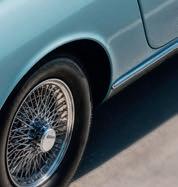

Backtrack
World Leather’s publishing cycle and limitations on space make it impossible for us to run more than a carefully selected sample of news from across the industry. However, we publish hundreds more stories on leatherbiz.com. The site is updated every day with news from every continent and every part of the industry, making leatherbiz.com one of the most comprehensive archives of news anywhere on the web for the global leather industry.
We list below just a few of the headlines that have appeared on the site in recent weeks and can still be accessed.
25 April 2025
Strong Q1 for Skechers, but uncertainty follows Collagen and Leather journal gains international indexing
24 April 2025
Q1 results confirm difficult start to 2025 for Kering
China’s footwear exports down, but leather shoes fare better
Puma collaboration features
Charles F Stead suede
23 April 2025
New leather workshop announced by Hermès
Operating profit falls in 2024 for Valentino
22 April 2025
Ethiopian leather could benefit from US tariffs, suggests business director
Modest growth across brands for Piquadro
17 April 2025
Volumes up, values down at Stella International
16 April 2025
New York listing moves closer for JBS
15 April 2025
Rebranding exercise complete at PrimeAsia
Bader – driving in style
14 April 2025
‘Good resilience’ for leathergoods at LVMH in Q1
Stellantis backs Maserati amid slump and tariff pressure
11 April 2025
What tariffs on four luxury groups might contribute to US coffers
10 April 2025
COTANCE walks away after group goes for fast fashion’s idea of durability
Pause for 90 days, but not for China
09 April 2025
A turning point in trade policy, VDA says
08 April 2025
WWF to hold supply chain traceability webinar
France calls for safeguard clause in Mercosur trade deal talks
07 April 2025
LHCA’s concession will be hard to implement, unfortunately
Warning of accelerated disintegration of global trade in goods
TFL releases autumn/winter 2026–27 colour trends catalogue
04 April 2025
Stock markets and trading partners respond to US tariffs
India eyes tariff opportunity shift
03 April 2025
Beef features in tariff thinking
Liberation Day likely to tie the world up in new trade war
Dr Martens celebrates iconic boot anniversary
One third of materials from recycled sources – LVMH
02 April 2025
Interior design tipped for strong growth Spring event of shoemaking returns in 2025
01 April 2025
Australian meat industry responds to US tariff speculation
ACEA: Tariffs will hurt automakers and US manufacturing
31 March 2025
British Pasture Leather promotes next field day
Suede celebration from Smit & Zoon AEC claims growth for Futurmoda
28 March 2025
Leather Days keynote to focus on Livestock in Material Flow Management
New research suggests overestimation of feedlot methane emissions
27 March 2025
Trump’s latest tariffs rock automotive sector
Fimec 2025 strengthens global industry connections
World Leather Day set for April
JBS reports a doubling of profit in 2024
26 March 2025
Study highlights potential for Brazilian footwear in Germany
Event celebrates tanners’ influence on Tuscan culture
25 March 2025
Caleres reports 2024 financial decline
Shoe exports up in volume for China, but values fall
24 March 2025
Government advances PLI scheme for leather
China: imports of hides and leather went up in volume in 2024
Firm focus on high-quality shoes at Stella International
21 March 2025
France maintains strong position in global leather trade
20 March 2025
Minerva foods reports record quarterly earnings
Tod’s extends blockchain to tell shoes’ stories
19 March 2025
Charlie Chaplin’s ‘Little Tramp’ boots to be auctioned in March
Tannery shares figures to celebrate World Recycling Day
Porsche to cut 4,000 jobs amid market challenges
Shoe division brings 7% growth for Inditex and partners
18 March 2025
Slight increase for global car sales in 2024
Jonathan Anderson to leave Loewe
17 March 2025
China: 30-point plan to boost domestic consumer spending
Eurofins introduces commodity chemical testing solution
New space for Hermès in Indonesia
Rag & Bone to push into leathergoods
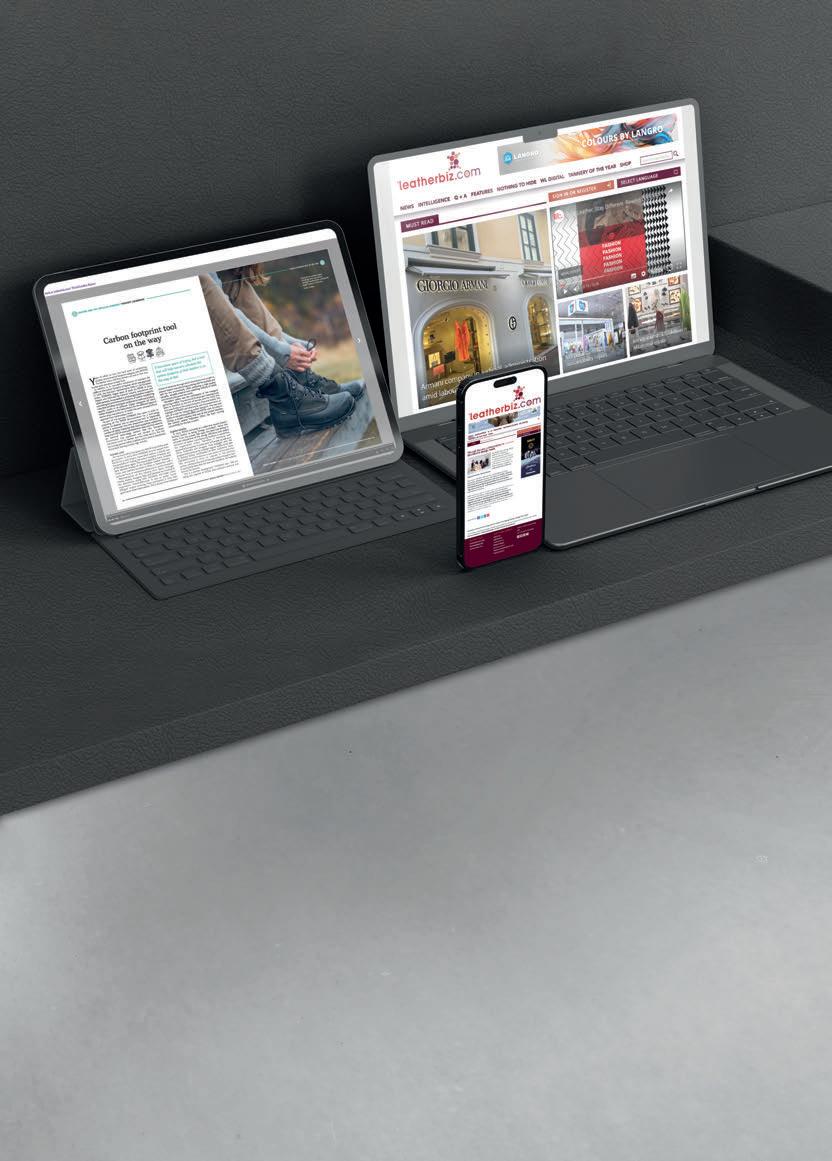
Leather Leaders: Gustavo González-Quijano
A clearer identity
The secretary general of the industry’s main representative body in the European Union is hopeful of greater support for industry in general from the new European Commission. He believes leather stands to gain because it will stand out as “the perfect material for the circular economy”.
How would you sum up the situation of the global leather industry in 2025?
Well it is really a very difficult moment that we are living through, globally, not only in the European industry. This is because of the geopolitical challenges that exist, starting with the implication of the wars (in the plural, unfortunately) that are going on. There are very important problems to face in Ukraine, in the Middle East and elsewhere. Beyond the human tragedy, all that has an impact on global trade; a lot of freight goes through the Strait of Hormuz and the Suez Canal. Energy prices are rocketing. US president, Donald Trump, seems to be a little bit nervous when it comes to applying tariffs to many trading partners. With all of this, Europe’s competitiveness is falling and you have a panorama that is not very easy. But it is important that we recognise these things, take stock and address the issues. We have to live in the real world. But, at the same time, we need to bear in mind that, in leather, we have a product that holds lots of good cards for the future.
What, within this, is the state of play in the leather industry in Europe?
The situation in Europe is the result of the policies that the previous EU Commission developed around its Green Deal strategy, with Frans Timmermans as the vice-president who had responsibility for climate action and for the Green Deal between 2019 and 2023. He gave a lot of leeway to DG Environment, the directorate-general of the European Commission that has responsibility for environmental policy. With very good intentions, DG Environment put forward a number of regulations that have had a serious impact on the European economy, weakening the economy overall and prompting important companies to exit Europe. This is now going to be addressed by the current Commission, which took office in December 2024. It has already put forward a number of so-called ‘omnibus packages’ in an attempt to reduce red tape and improve efficiency. Now we have the Competitiveness Compass, a new roadmap to boost economic growth. We all want the objectives to be achieved, but the way the
Secretary general of COTANCE, Gustavo González-Quijano.
CREDIT: WTP
objectives have materialised in regulations is totally unrealistic. That is why it is important for a kind of redrawing of the legislation to take place and make it more realistic.
What is the European Commission’s level of sympathy for and understanding of the work of the hide traders, tanners and craftspeople who work in the leather value chain in the European Union?
It is still early days for this new Commission. We will need to wait and see what the proposals look like when they arrive. For the time being, I don’t yet have too much of a sense of how things are going to go. We have written to the commissioner for the environment and to the commissioner

for industry to ask for meetings with them. So far, we are still waiting for a response. What I can say is that it looks as though the new policies that the new Commission has outlined will be much more aligned with the needs of the industry, and not only of our industry, but all industries. For example, it will address Farm to Fork, a strategy it first published in 2020, and there will be new agricultural objectives. And, for industry, there will be a new competitiveness deal that will be implemented.
Based on long years of working to build unity and leadership in the leather industry, what, in your opinion, are the main factors that have prevented higher levels of both unity and leadership in the global industry?
The leather industry is a fragmented sector. We do not have any leverage with our suppliers and we do not have any capacity to influence our customers. We are squeezed between two worlds. Maybe we are going to continue to be torn between these two worlds, or maybe we are going to become part of one or the other, part of the world of the meat companies that supply the hides, or part of the luxury and fashion sectors that use finished leather. I don’t know. But, in any case, the industry is struggling to find its place and occupy it. We have medium-sized enterprises, small and micro enterprises, and many craft enterprises. It is difficult to bring all of these together. We have a fantastic organisation at international level, the International Council of Tanners, managed wonderfully by its secretary, Dr Kerry Senior, from Leather UK, and under the current leadership of Bekir Burak Uyguner from Turkey. They are doing a really good job of making people from different countries understand how important it is to come together under one system of governance. There is no need to create a new organisation or a new association. That is not necessary. But we need to use the organisations that exist in the sector already. They can bring people together and make sure we are all pulling on the same thread together. We don’t need a new organisation. What we need is fewer free-riders.
What have been the main consequences of the lack of a single voice for the industry?
The consequences are clear to everybody: we don’t have the influence that we should have. Other industries have been able to bring together the whole value chain and to speak with one voice, and they are more successful than us. If we do not achieve this unity, we are going to struggle in the future. I think now is the time to make this paradigm shift and come together to pull on the same thread at the same time and achieve our objectives.
What could bring about this paradigm shift in the current context in which we are living and working?
What we are working to make clear is that leather is the perfect material for the circular economy and that is the future. We hold all the cards for achieving this. Leather is a natural material. It is biodegradable at the end of life. It is renewable at the beginning of the lifecycle. It is one of the most beautiful materials that exist and one of the most durable materials for the future. Recognition of these qualities is what we need to push for. If we can push all together we may achieve our objectives.
A clearer identity
“ We have hope for the future; the circular economy is going to be a game-changer for many industries, including for our industry.”
What grounds are there for optimism that the industry can achieve this in the second half of the 2020s?
Europe is maybe one of the regions that is introducing most of the regulations that are driving changes in the global leather industry. We need to come up with authenticity rules. The US is doing this with the proposed Consumer Protection and Automotive Transparency Act in the state of New York. We in Europe are working on integrating leather authenticity rules into textile labelling regulations. This is going to give to the industry a clearer identity and the chance to link to this identity a number of features that are important for the circular economy. That is why we have hope for the future. The circular economy is going to be a game-changer for many industries, including for our industry. For our industry it is going to have a positive impact because we will be able to show that our environmental credentials put leather ahead of other materials that are competing for the same markets. I think our customers and brands are going to be able to identify leather as one of the most sustainable materials you can have.
Will this also impact public spending? If public spending needs to go on sustainable products, will this help make sure there is leather in the furniture, footwear, cars, public transport and so on that governments spend money on?
There are rules about public procurement and there are going to be more rules in place for green public procurement. For now, textiles is a sector that is much more active in this area. We need to work to make leather part of the requirement for green public procurement. That’s why it is important to make sure there are sound eco-design requirements and an EU identity in the textile labelling regulation. Eco-design requirements for footwear are coming in 2026 or 2027 and we are already working on relevant horizontal aspects and looking at what is going on in the textiles sector. Requirements for textiles are probably going to be used as a model for setting up the requirements for leather. Yet, questions concerning durability and biodegradability are not the same for leather as for textiles. For example, we want biodegradability to be recognised as recycling at the end of life. It is recycling, with nature. Over time COTANCE has been participating in, contributing to, sponsoring and promoting peer-reviewed scientific papers. These include one on the absence of links between leather and deforestation that the Sant’Anna School of Advanced Studies in Pisa published last year, and one on carbon analysis that Ars Tinctoria published in 2023. There was also the paper comparing leather against synthetic substitutes that FILK published in 2021. We have a number of science-backed documents that we can use to put forward the environmental credentials of leather, from a factual point of view.

leather.evolvedbynature.com

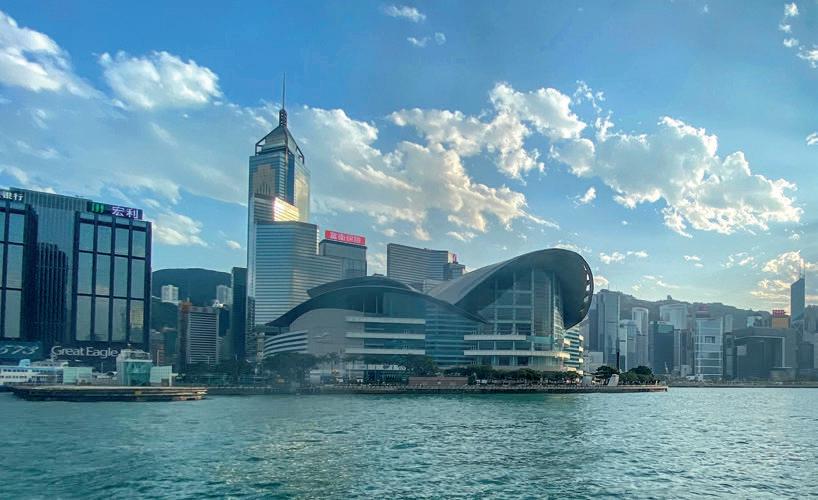
“Accentuate the positive Eliminate the negative Latch on to the affirmative” *
Now entering its fifth decade, the 41st edition of APLF didn’t quite match the buzz of the previous year. The 40th event, returning to Hong Kong after a pandemic hiatus, brought a renewed sense of excitement that helped the industry push through lingering challenges. However, by 2025, with two major trade shows already held in India and Italy, the atmosphere felt more subdued. While global conflicts and ongoing uncertainties kept leather demand somewhat muted, the political landscape — marked by shifting trade relations and fluctuating messages — further slowed the momentum seen in earlier editions.
The days of major deals being struck at trade shows belong to the past. Today, relationship management takes precedence, and for many, simply keeping business afloat during tough times is the best they can hope for as they await a return to more prosperous days. Despite these challenges, the industry continues to adapt, focusing on the positives and celebrating the “little wins”.
These small victories were certainly a topic of discussion. Innovations in tanning technologies were met with enthusiasm, and the industry’s growing acceptance of Life Cycle Assessment (LCA) data marked a significant shift. What was once met with resistance is now seen as a valuable tool for transparency and collaboration across the entire leather supply chain. This progress has been encouraged by
the revised Higg Index and its updated MSI data. On that note, it is worth remembering that Ecoinvent’s data sets for fossil-based materials were also updated late last year, increasing their recorded environmental impact. One can’t help but wonder: Will the full supply chain of plastic-based leather alternatives ever be scrutinised with the same rigour, including drilling, extraction, and refining? We can but hope and whilst we may be asked to justify our existence, these are the cards that we have been dealt and we must keep moving.
The event featured just over 600 exhibitors from 40 countries and regions, including 24 group pavilions. These numbers indicate a slight decline compared to 2024, which is not surprising given the current state of the industry. This decline highlights a sense of caution within the sector.
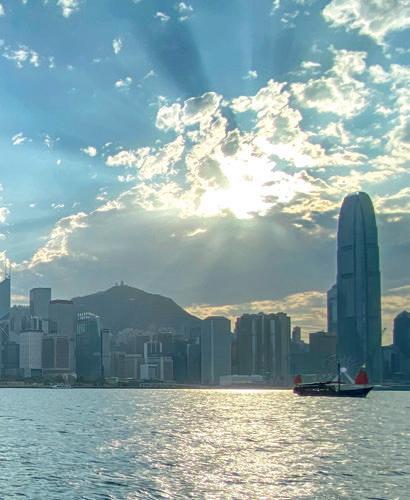
“Accentuate
the positive, eliminate the negative, latch on to the affirmative”
The Hong Kong Convention and Exhibition Centre viewed from the Star Ferry in the Victoria Harbour ALL CREDITS: WTP
shaping market trends and influencing leather prices throughout the first three quarters of 2025. With 25 side events — including seminars, talks, and business-matching meetings — spread across three days, Ms Lee noted that these additions were a direct response to visitor feedback, particularly the demand for more in-depth industry insights and a strong focus on educating Generation Z. She also pointed out that such initiatives had previously led to increased foot traffic. The exhibition’s proximity to mainland China continues to make it a strategic stop for visitors, whether before or after the event. Additionally, Hong Kong’s compact city layout ensures that post-show networking remains centralised in familiar venues, with Joe Bananas being a notable hotspot.
Looking at the economic data from 2024 and 2025 in general, there is a clear contrast between regions, with geopolitical tensions still influencing growth and confidence levels and, as much as these numbers give us a snapshot, the ever-changing political landscape means these figures can be as stable as a house of cards – so do not be too surprised if they shift soon!
On a positive note, the attendee list included representatives from past exhibitors, which is an encouraging sign. This suggests that while the event continues to attract interest, some companies may find it more valuable to allocate their budgets towards directly engaging key customers and holding meetings away from the exhibition stands instead of exhibiting. Figures released by the organisers indicate that attendance was down slightly, by just under 10%. This is not unexpected, as last year’s event was dubbed the “Hong Kong Reunion”.
As with many recent shows, the distribution of industry sectors — hide merchants, chemical manufacturers, machinery manufacturers, and tanners — followed a familiar pattern. With the industry as a whole remaining flat, the main source of optimism came from hide suppliers and chemical manufacturers, while machinery manufacturers took a more cautious, if not pessimistic, view.
One key takeaway from the event is that, despite past speculation that the larger ACLE show might overshadow or even end the Hong Kong event, reality has unfolded differently. The Shanghai exhibition has largely become a domestic affair, catering primarily to the Chinese industry with only limited participation from European and international businesses. In contrast, APLF has firmly established itself as a truly international trade show, focusing on volume production leathers rather than the high-fashion offerings typically showcased at Lineapelle.
Crunching the numbers
Many international organisations, including the IULTCS, ICHSLTA, ICT, and Leather Naturally, hold their annual meetings at APLF, underscoring the event’s global significance. At the inaugural press conference on March 12, newly appointed event director Janice Lee marked the exhibition’s entry into its fifth decade. She expressed confidence that APLF participants would play a key role in
In 2024, according to reports in Trading Economics, the Euro area’s GDP growth was stagnant at 0.1%, while India and China were set to grow at 7.6% and 5.2%, respectively. The US economy expanded by 3.1%, thanks to government subsidies. Consumer confidence in India and China was strong (92.3 and 87.6), while the Euro area (-15.5) and the US (79.6) were weaker. PMI data mirrored this, with India at 56.7, China at 50.8, the US at 51.1, and the Euro area at 46.1.
In 2025, the Euro area’s GDP growth remains sluggish at 0.2%, with India and China expected to grow at 7.3% and 5.0%. The US economy is forecast to grow at 2.9%, a slight dip. Consumer confidence in India and China has dropped slightly to 116.4, while the US (80.2) and Euro area (21) remain lower. PMI figures show India at 55.2, China at 51.3, the US at 50.7, and the Euro area at 45.9, according to the reports. While the Euro area has seen minor improvements, it still faces challenges. India and China continue to outperform, despite global uncertainties, while the US is showing slower growth than last year.
Breakfast communication
At the Leather Naturally (LN) breakfast, held on the morning of the second day, its chairman Luis Zugno opened the meeting with a rather different message, thought provoking and tackling a difficult topic — the sustainability of the leather industry as a whole, which is under threat from multiple factors. He highlighted not just the potentially water-intensive processing and the chemicals used but also the sheer amount of power required — not only in the tanning process itself but also in the physical movement of raw materials and finished products, a system that has remained largely unchanged for the last 4,000 years. Expanding on his point, he turned to the end-of-life challenge, noting that while many leathers are biodegradable, few are truly compostable. This is just one of several pressing issues facing the industry,
“Accentuate
alongside increasing regulatory challenges. However, Mr Zugno asserted that Leather Naturally has the potential to drive change and help the industry navigate these obstacles as it moves forward.
Following this, Kim Sena, a member of the LN board and currently Sustainability Director for JBS Couros, took the floor to provide an overview of the recent LCA guide, in which Leather Naturally played a key role. The guide offers valuable insights for stakeholders and consumers interested in the environmental impact of leather production. LCAs assess a product’s environmental footprint across its entire life cycle, from raw material sourcing to disposal, helping companies evaluate sustainability at every stage while keeping pace with evolving regulations.
Focusing on bovine leather, the guide draws on industry research to present data-driven analysis and practical applications. It covers 56 different LCA studies from six major tanning companies across 11 different locations. One of its key takeaways is the updated Higg Index dataset, developed in collaboration with the Leather Working Group (LWG). The new data shows that the environmental impact of bovine leather is 55% to 67% lower than previously reported, with global warming potential reduced by 60%, while metrics for eutrophication and chemical impact have both fallen by over 60%.
Mr Sena noted that these findings could and should prompt brands to rethink their stance on leather, as the data challenges common misconceptions and has meaningful implications for material selection. He also emphasised that this is far from the final word — ongoing process optimisation will continue to drive further reductions in LCA values over time.
To close the meeting, Dr Kerry Senior, a newly appointed Leather Naturally board member, moderated an open Q&A session to gather the audience's insights. Comprising members, supporters, and other interested parties, the audience was invited to share their views on the future of Leather Naturally. Dr Senior acknowledged the valuable content on the LN website and the quality of the session's presentations, then posed a critical question: Why are membership numbers declining?
This led to a lively discussion on whether LN should focus its messaging on consumers or brands. Several participants cited practical examples where consumerfacing campaigns had failed to gain traction, suggesting that consumers, while influential, often only purchase what's readily available. One audience member, who supplies leather to major shoe producers, highlighted that brands will not stock products that do not sell, and ultimately, it is the brands that must educate consumers. The conversation also touched on the need for greater communication within the supply chain, though a reluctance to share messaging with competitors complicates matters. In the end, it was clear that while the industry is educated, the messaging needs to be amplified externally, where we can all play our own personal role.
Side events
APLF 2025 hosted a series of onsite events focused on education, information sharing, and industry engagement, reinforcing APLF’s commitment to serving the leather

sector. The Global Footwear Summit brought together 100 top executives, industry leaders, and professionals from the global footwear industry, offering a platform for discussing key topics such as sustainability and compliance, with World Leather Technical Editor Mat Abbott serving as a panellist. The third edition of the LED Project saw designers from China, Vietnam, Japan, and Pakistan collaborate with top tanners to create distinctive leather fashion pieces, showcasing the versatility of Tuscan vegetable-tanned leather.
The Best of APLF Awards recognised outstanding exhibitors across APLF Leather, Materials+, and Fashion Access, setting a standard for future industry participation. Additionally, the Design-A-Bag Online Competition concluded with Eliane Yahari from Argentina emerging as the overall winner for her design, the Yvoty Bag, while Uthra S Ganesh from India and Jiang Si Mi from China were named finalists.
APLF 2026 is already in planning, with the next event set to take place in Hong Kong, 12-14 March 2026.
* Johnny Mercer, US lyricist, 1944.
Eliane Yahari from Argentina was the overall winner of the APLF Design-ABag online competition for her design, the Yvoty Bag.


























makes it

Renewable sources
Nobody does it like Ecotan! We have pioneered the most innovative technology for naturally tanning leather, introducing a truly biocircular process. This ensures unparalleled quality, hygiene and comfort, alongside robust sustainability in every leather article right from the initial design phase. The ultimate choice for car interiors.

GSC Group outlines latest sustainability initiatives
GSC Group, a long-established manufacturer in the leather chemicals sector, has outlined its latest sustainability initiatives in its 2023
Sustainability Report. With nearly 50 years of experience, the company seeks to integrate technological advancement with environmental responsibility, focusing on circular economy principles, energy efficiency, and innovation in leather processing chemicals.
The latest report from the Italian chemical manufacturer highlights key areas of progress, including investment in renewable energy, bio-based chemistry, emissions reductions, and sustainable research. While these efforts demonstrate an ongoing commitment to environmental and social responsibility, The GSC Group acknowledges the complexities and challenges involved in making the leather industry more sustainable. One of its stated priorities is to increase reliance on self-generated renewable energy. In 2023, the company generated 15% of its total energy needs through photovoltaic systems, which, it claims, prevented 132.5 tonnes of CO₂ equivalent emissions. However, it acknowledges that further efforts are needed to reduce its dependence on external energy sources and fossil fuels.
R&D Manager, Francesco Serafini, explains, “To increase the percentage of self-generated renewable energy, it is essential to expand the available photovoltaic surfaces. Therefore, we have invested in a new 12,000-square-metre facility in Montebello Vicentino, where around 4,000 square metres of solar panels will be installed. This will allow us to double our energy self-production and improve operational sustainability.”
These developments align with broader industry trends, where manufacturers are under increasing pressure to shift towards renewable energy sources. However, it remains to be seen whether these measures will be sufficient to meet long-term decarbonisation targets, given the energyintensive nature of leather chemical production.
GSC Group’s sustainability journey began in the early 2000s, driven by innovation, technology, and expertise, continuously expanding in plants, products, and certifications.
CREDIT: GSC GROUP
Advancing bio-based chemistry
The development of bio-based chemicals is a key focus as it seeks to reduce reliance on fossil-derived raw materials. However, one of the main challenges in transitioning to more sustainable alternatives is maintaining the same level of performance as traditional petrochemicalbased products.
To address this, the company states that it has adopted a rigorous research and development process. More than 10% of its annual budget is allocated to R&D, with additional investments planned for new laboratory facilities and equipment. It also claims that its quality control system is designed to ensure that bio-based formulations meet performance expectations, with over 60,000 chemical and application tests carried out annually.
“We continuously invest in R&D to formulate bio-based products using high-quality raw materials, testing them to ensure both effectiveness and stability. On average, our laboratories verify 20,000 products per year, conducting up to 100,000 quality control analyses. This level of testing is critical to maintaining high performance standards while transitioning to more sustainable chemistry,” says Mr Serafini.
Customer collaboration is also a factor in product development, with approximately 53,000 leather tests conducted and 6,500 leather samples verified on request annually. This approach is intended to allow continuous optimisation of formulations based on real-world applications. However, the wider adoption of bio-based chemicals across the industry remains a gradual process. While these efforts indicate a commitment to sustainability, challenges such as raw material availability, cost, and regulatory compliance continue to shape the pace of change.
Addressing Scope 3
Scope 3 emissions — those generated across the supply chain — represent one of the biggest challenges for companies seeking to reduce their overall environmental impact. According to Mr Serafini, indirect emissions account for the majority of its carbon footprint, particularly those associated with raw material procurement. “The reduction of Scope 3 emissions represents a strategic goal for our business, achieved through close collaboration with suppliers across the entire production chain. We prioritise suppliers that provide bio-based and renewable raw materials, reducing dependence on petrochemical derivatives and lowering overall CO ₂ emissions as much as possible.”
To support these efforts, the company adheres to the Zero Discharge of Hazardous Chemicals (ZDHC) programme, with 417 registered products meeting ZDHC compliance standards. In 2023, it claims to have achieved a 4.2% reduction in the sales of Manufacturing Restricted Substances List (MRSL) chemicals, which it attributes to investments of approximately €100,000 in safer alternatives. Transportation-related emissions are another area of focus. The company claims that it has taken steps to reduce its logistical carbon footprint by favouring local and regional suppliers where possible. Additionally, it was the first Italian business in the leather chemicals sector to participate in Carbon Footprint Italy, a national programme
aimed at monitoring and reducing greenhouse gas emissions. While these measures indicate progress, the effectiveness of supplier engagement strategies in significantly reducing Scope 3 emissions remains a challenge across the industry. The extent to which such initiatives contribute to overall emission reductions will likely depend on the broader availability of sustainable raw materials and supply chain efficiencies.
Innovation and collaboration
A key investment in its long-term sustainability strategy is the construction of a new leather application laboratory in Zermeghedo. Scheduled for completion in September this year, the 6,500-square-metre facility is expected to be one of the largest of its kind in Europe.
The laboratory will focus on the development of new formulations for wet-end and finishing processes, with plans to introduce an integrated digital system for tracking formulations, which it claims will improve efficiency and record-keeping in the development process. A dedicated area will also be allocated to customer support, offering physical leather testing and colour analysis services.
Although research into new sustainable raw materials will remain within the Montebello Vicentino headquarters, the new facility aims to contribute to the development of more environmentally friendly technical formulations with improved Life Cycle Assessment (LCA) results.
The Zermeghedo laboratory will be featured in an upcoming issue of World Leather, where further details of its research focus and expected impact will be explored.
Looking ahead
The group’s latest sustainability report provides an insight into its ongoing efforts to integrate environmental and social responsibility into its operations. It claims to have made significant progress in key areas such as renewable energy expansion, bio-based product development, and supply chain emissions reduction. However, the extent to which these initiatives contribute to broader industry decarbonisation goals will depend on their long-term impact and scalability.
The completion of the Zermeghedo laboratory will represent a substantial investment in research and collaboration, signalling the intent to remain at the forefront of sustainable leather chemistry. The company seeks to use this facility as a platform for industry engagement, supporting both product development and wider sectoral innovation.
Nevertheless, challenges remain. The transition towards sustainability in the leather chemicals industry is a complex process, influenced by factors such as regulatory developments, raw material availability, and economic pressures. While the group’s initiatives align with global sustainability objectives, ongoing assessment will be required to determine the effectiveness of these measures in achieving meaningful environmental improvements.
As the industry continues to evolve, the ability of the company to adapt and expand its sustainability strategies will likely play a key role in its future positioning. The coming years will provide a clearer picture of how these investments translate into measurable progress towards a lower-impact leather chemicals sector.



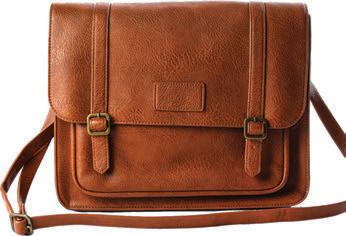


Carbon unleashed: the circular carbon revolution
Gustavo Adrián Defeo FSLTC CTC Ars Tinctoria
As the demand for sustainable materials continues to rise, understanding the carbon content of various products has become crucial. The origin of carbon, whether fossil-based or bio-based, plays a key role in determining the environmental impact of materials. The shift from fossil fuels to bio-based sources can significantly reduce carbon emissions, even at the end of a product’s life cycle. Accurate quantification of bio-based carbon is essential for transparency in sustainability claims, enabling industries, policymakers, and consumers to make informed decisions. Standards, such as those developed by CEN/TC 411, provide clear guidelines for measuring and certifying bio-based content, supporting the transition towards a more sustainable, circular economy.
Carbon, along with other biogenic elements such as nitrogen, oxygen, and hydrogen, was pivotal in the emergence of life on Earth, leading to the creation of vast reserves of fossil carbon throughout the planet's evolution. Fossil carbon, found in coal and oil, belongs to a bygone biospheric equilibrium. For centuries, these fossil fuels have been used by humanity to generate heat and light. However, the large-scale use of fossil carbon as an energy source since the Industrial Revolution has accelerated the depletion of these resources, simultaneously increasing the emission of carbon dioxide into the atmosphere. The rise of horizontal drilling for oil extraction, a method where a well is first drilled vertically and then turned horizontally to access a wider area of the underground reservoir, has also contributed to this, releasing additional fossil methane. Horizontal drilling has enabled the extraction of fossil fuels from challenging geological formations like shale, making it more efficient to access larger volumes of oil and gas. Both carbon dioxide and methane are the leading greenhouse gases, and their unbalanced increase is a key driver of global warming. Historically, clothing, footwear, belts, and other accessories were crafted from natural, renewable, bio-based materials. Leather and fur were the first materials mankind learned to
preserve, maintaining their unique protective qualities. With the advent of agriculture, natural fibres including cotton, wool, hemp, and silk evolved from artisan crafts to mass production, particularly after the Industrial Revolution, leading to increased environmental impact.
Over the past two centuries, the petrochemical industry has grown exponentially. The invention of Bakelite in 1907 marked the beginning of the synthetic polymer era, followed by the widespread development of plastics such as polyethylene, nylon, polyurethane, and polyester. These materials spurred innovation across various industries, enabling mass production of goods like packaging, disposable tools, fashion items, and cheap consumables. However, the rise of synthetic polymers has also posed significant environmental challenges, as these materials persist in the environment, evolving into so-called “forever chemicals” with limited biodegradability. Their breakdown process results in the gradual formation of micro- and nano-plastics. While plastic recycling is possible, the reality is that less than 9% of produced plastics are recycled. This presents a significant issue in dealing with plastic waste, as recycling still produces persistent plastic forms, while incineration increases atmospheric carbon dioxide, and ongoing fossil drilling continues to release methane. In response, several
governments have implemented policies, such as the EU Green Deal and UN Sustainable Development Goals, to reduce the use of fossil-based materials and address this environmental crisis.
Leather, however, has remained a cornerstone of the fashion industry, appreciated for its durability, versatility, and enduring appeal. As the industry transitions to sustainability, leather continues to be a valuable bio-based material, offering a natural alternative to synthetic, petroleum-derived textiles. Unlike plastic-based vegan alternatives to leather, which contribute to microplastic pollution, responsibly sourced leather can be one of the most sustainable options when produced using ethical, eco-friendly methods.
In recent years, various bio-based material alternatives have emerged, claiming to be derived from renewable biological sources including plants, fungi, and agricultural waste. These materials promised sustainable solutions to the environmental impact of traditional textiles and leather, though many still rely on fossil-based polymers, toxic chemicals, and resourceintensive processes.
In this context, the origin of carbon plays a crucial role in sustainability and circularity, particularly considering its harmful environmental impact when mismanaged or overused. Shifting from fossil carbon to bio-based sources can significantly reduce atmospheric carbon emissions, even when incinerated at the end of their lifecycle. The ability to quantify the proportion of fossil versus bio-based carbon in materials has become a key parameter for transparent sustainability claims.
However, bio-based content alone does not provide insight into a product’s overall environmental impact or sustainability, which can be evaluated through life cycle assessments (LCA) and sustainability criteria.
While bio-based content is a valuable parameter for assessing a material's circularity, it is not the only consideration. Sustainable materials result from a series of circular processes, where factors such as energy consumption, transport, land and water use, waste management, and end-of-life options must also be accounted for.
In this context, CEN/TC 411, the European technical committee responsible for the standardisation of bio-based products, is working to develop standards that ensure transparency, reliability, and consistency in the production, labelling, and certification of materials derived from renewable biological resources. These standards are critical for facilitating the transition from fossil-based to biobased economies by providing clear criteria for sustainability, bio-content determination, and performance evaluation and communication.
CEN/TC 411’s standards cover key areas such as terminology, testing methods, sustainability assessment, certification schemes and communication for bio-based products. By establishing harmonised standards across Europe, the committee enables industries, policymakers, and consumers to make informed decisions, fostering innovation while ensuring both environmental and economic benefits.
The standards developed by this commission are transversal across all sectors, enabling the comparison of material performance regardless of origin. This is crucial in an eco-design context, where it is essential to assess different materials using the same parameters. Such comparability helps avoid misleading or greenwashed approaches.
As with most standardisation committees, a common
language is established through clearly defined terms. For CEN TC 411, these definitions are provided in EN 16575:2014 (Bio-based products — Vocabulary).
The biomass content of materials is defined in two key standards:
• EN 16640 (Bio-based products — Determination of the bio-based carbon content of products using the radiocarbon method)
• EN 16785, Parts 1 and 2
Part 1: Determination of the bio-based content using radiocarbon and elemental analysis
Part 2: Determination of the bio-based content using the material balance method
EN 16640 outlines the process for quantifying the bio-based carbon content of materials using radiocarbon measurement. The term “bio-based” refers to products derived wholly or partly from biomass, making it essential to accurately quantify biomass content. For this purpose, both EN 16785-1 and EN 16785-2 were developed.
While biomass content is critical in determining the intrinsic circularity of carbon-based materials, a thorough life cycle analysis must also consider additional factors — environmental, social, and economic impacts across the supply chain. These broader sustainability aspects are addressed in EN 16751 (Bio-based products — Sustainability criteria).
To support clear and trustworthy communication throughout the bio-based value chain, a harmonised certification and declaration framework is essential to combat greenwashing. Two standards address this need:
• EN 16848 (Requirements for Business-to-Business communication of characteristics using a Data Sheet)
• EN 16935 (Requirements for Business-to-Consumer communication of sustainability claims)
A data sheet developed according to EN 16848 must include the following information:
• Type of biomass (e.g., plant-based, tree-derived, algae, marine organisms, microorganisms, animals, or combinations thereof, including proportions)
• Geographical origin of the biomass (indicating supply chain length)
• Bio-based content, measured as verifiable biological carbon relative to total carbon (EN 16640) and to biomass content (EN 16785-1/2)
• Socio-economic impact of the biomass, in line with EN 16751
• End-of-life options, including certified impact assessments
• Additional information, such as life cycle assessments (LCA) and other environmental claims, provided they are scientifically substantiated
It is important to note that within this standard, LCA and similar certifications are treated as “additional information”. This ensures the focus remains on the material's intrinsic properties, rather than on potential carbon offsetting or compensation strategies
Regarding EN 16935, which covers B2C communication and sustainability claims, the mandatory information is essentially the same as in EN 16848. However, it must clearly specify which information refers to the product itself and which refers to the packaging.
Rolling into the future

Gemata has long been known for its focus on innovation in the leather industry, developing new technologies to improve efficiency and sustainability. According to the company, the Greenstar roller coater is designed as an advanced solution for the reverse finishing of whole hides and bovine sides. It aims to combine technical performance with environmental responsibility, offering features that claim to enhance both production efficiency and sustainability. With working widths of 3400mm and 3800mm, the machine is marketed as a step towards reducing emissions and improving resource efficiency in industrial leather finishing.
Since its initial release, the roller coater has undergone a series of updates aimed at enhancing its functionality. A key addition, available as an option, is the integration of an RFID system that stores critical data directly on the engraved cylinder. This allows for enhanced tracking of usage, as well as predictive maintenance, contributing to more efficient machine operation. Another optional feature is the shift from manual doctor blade adjustment to an electronically calibrated system, driven by stepper motors, has improved precision and reduced wear. Additionally, an optional spreader with a dust removal system has been introduced, employing an air blade and suction hood to remove fine dust from the grain side of the leather, potentially improving the quality of the finish. Greenstar is designed to integrate seamlessly with smart manufacturing systems via an optimised Open Platform
Communications Unified Architecture (OPC-UA) protocol. This ensures secure, real-time communication with other Industry 4.0 technologies — such as Internet of Things (IoT) devices, Manufacturing Execution Systems (MES), and Enterprise Resource Planning (ERP) systems — enabling greater automation, connectivity, and data-driven decisionmaking across modern production environments.
Sustainability is a key focus in the design of the roller coater. Compared to traditional spray systems, this machine significantly reduces resource consumption. It reportedly achieves a 50% decrease in chemical usage, as well as reductions of 75% to 95% in water, electricity, and compressed air. Additionally, the system eliminates the costs associated with sludge disposal, which are often incurred in conventional finishing processes due to overspray. With an energy consumption of only 3.85 kW for leather processing,

it sets a new standard beyond the company’s already energy-efficient Megastar model. These energy savings result from advanced motors and optimised application methods that lower environmental impact while ensuring production efficiency.
Designed to handle a wide variety of leather types due to its patented conveyor system, it features a thick rubber belt supported by a large-diameter counter-roller, which ensures uniform coating and high-quality finishing, even on leathers with a low grain. The four adjustable positions of the belt at the exit of the coating area, combined with constant tension control, provide flexibility for different leather types and contribute to an extended belt lifespan. Furthermore, the system eliminates the need for a detaching roller, which can sometimes lead to chemical contamination on the flesh side of the leather. The small diameter return roller and thick rubber belt facilitate smooth leather release, preventing jamming during the process.
The machine is compatible with a wide range of finishing chemicals, including resins for impregnation, oils, waxes, fillers, pre-bases, bases, coatings, and water-based fixatives. It also supports newer film technologies, making it suitable for primers and pre-bases used in systems such as Multi Greenfinish and Full Greenfinish. This versatility ensures precise coverage and application, even on leather with significant defects or variations in thickness.
Component durability is a key consideration in the design of the roller coater. Low-friction, long Life cylinders can be employed to ensure uniform processing, even on softer hides. These cylinders promote consistent product discharge and simplify cleaning operations. The RFID system that stores engraved cylinder data aids in maintenance planning, providing accurate estimations of cylinder lifespan to assist with timely replacements and minimise downtime.
While performance in various production environments will depend on factors such as maintenance practices, chemical selection, and leather characteristics, the updated roller coater represents a significant advancement in leather finishing technology. By incorporating automation, digital tracking, and energy-efficient technologies, the machine supports the ongoing shift towards more sustainable practices within the leather industry.
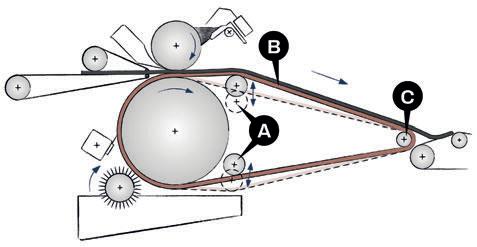
The belt’s four adjustable positions at the exit of the coating area (A) and its constant tension ensure precise adaptation to any leather type, guaranteeing high-quality finishing and extending the belt’s (B) lifespan. Additionally, the belt (C) enables uniform impregnation of leathers with large quantities of liquid products.
The small diameter return roller (C) and the thick rubber belt (C) ensure smooth leather release, eliminating the need for a detaching roller and preventing jamming or chemical contamination on the flesh side.
Leather and the circular economy
Credit: WTP/Flaticon
Fund raises hopes as well as money
Campaign group World Wildlife Fund (WWF) has formally unveiled an initiative called the DeforestationFree Leather Fund. Its aim is to collect an initial $10 million over the next three years from companies in the leather sector to fund initiatives that will support traceability, sustainability and resilience in the leather supply chain.
Projects that the new fund will finance will target places that, according to WWF, are at higher risk of environmental degradation. The solutions will accelerate what it calls “deforestation- and conversion-free sourcing from those regions”. These projects will, initially, be in Brazil, but the possibility exists of expanding the work to other beefproducing countries in South America in the near future.
“While leather is a by-product of the beef and dairy industries, it still carries responsibility for embedded impacts and emissions in the supply chain,” says WWF’s senior director for beef and leather supply chains, Fernando Bellese. “Companies that use leather, including those in the fashion, automotive and furniture industries, have unique leverage within the supply chain to encourage and support more sustainable practices by influencing beef and tannery operations.”
WWF has said it is already working to secure contributions to the fund from brands, retailers, leather processors and finished product manufacturers. The fund will enable these
An initiative that WWF has launched aims to raise an initial $10 million to help fund deforestation-free sourcing of hides. It says this will just be the start.
contributors to deliver “deforestation-free commitments”, it says, and send “strong market signals” to livestock farmers and meat companies. It aims to use the initial $10 million to tag 1 million head of cattle in the first three years and help the regeneration of at least 15,000 hectares of land. Another aim is to help small- and medium-sized farms “to transition” in their own operations, resulting in the recovery of a further 30,000 hectares of degraded land.
Value-driver
Accessories group Tapestry is one of the first companies to make a financial commitment to the Deforestation-Free Leather Fund. This commitment is in addition to the Tapestry Foundation’s four-year, $3 million philanthropic grant to WWF in 2022, which has already led to the development of a
from other sectors (meat and dairy) is the input for making leather
Use of leather aids the battle against marine pollution, also part of the SDGs
The leather industry opens up pathways into the circular economy for companies of all sizes, including many thousands of small and medium enterprises
Leather content fulfils finished product manufacturers’ desire to use recycled material
Finished products made from leather will meet criteria for green tax relief and for green procurement exercises Leather manufacturing supports green employment commitments
“We hope the fund will run until deforestation is no longer a hot topic.”
FERNANDO BELLESE, WWF
system to enhance traceability in the leather value chain (see World Leather, February-March, 2025).
Speaking about the new Fund, Tapestry’s vice-president for ESG and sustainability, Logan Duran, says: “We believe strongly in the importance of sustainability in leather manufacturing, and this commitment reaffirms that belief. We invite other companies, within and outside our industry, to join us in these efforts.”
Mr Duran adds that one of the reasons Tapestry looks on the DeforestationFree Leather Fund as “a positive development and a value-driver” is the support it will provide in meeting regulatory requirements, including the European Union Deforestation Regulation (EUDR).
Leather connections
A native of the Brazilian state of Minas Gerais, Fernando Bellese worked for many years in the leather industry before joining WWF. He held various roles at JBS Couros for eight years, ending up as its marketing and sustainability manager, ultimately basing himself in the US. In 2019, he moved to become the chief sustainability officer at another leather manufacturing group, PrimeAsia. He stayed in that role until 2022, when he moved to WWF. Years after moving north, his love of Brazil and its landscapes remains strong.
“Tropical forests and natural ecosystems are critical to our wellbeing,” he argues. “They work as an important carbon sink, helping the fight against climate change. They support water availability and, in general, balance in the natural world.” But he says that in areas in which deforestation occurs, all of these factors suffer. “We are seeing more extreme weather in South America,” he continues, “with droughts and floods happening at the same time. For the sake of nature, and for the sake of human beings, we need to address this sooner rather than later.”
WWF figures suggest that, between 2001 and 2023, the world lost 430 million hectares of tree cover. The figure for Brazil alone was 68 million hectares over
Fund raises hopes as well as money

the same period, an area greater than that of the whole of mainland France.
“Agricultural commodities have a strong connection to deforestation,” Mr Bellese says, “and cattle production is the top driver for it. But we also need to see that another part of this story is that the demand for food is continuing to increase and cattle production is part of that equation.”
Using, again, WWF figures, he puts the increase in food production that the world needs to achieve between now and 2050 at 70%. Cattle production, as a part of the response to growing food demand, will need to go up by 20% over the same period. What this tells the former JBS executive is that organisations like WWF need to work with the livestock farming and meat sectors. He believes this can help beef production become more efficient and more sustainable, without any need to clear new areas of forested land.
This entire discussion connects to leather, of course, because the leather industry’s ties to cattle farming and meat and milk production are unbreakable.
For Fernando Bellese, this means that the leather sector, while not the cause of deforestation (because no farmer anywhere raises cattle to produce hides), needs to have a voice in the deforestation discussion. “More and more consumers are asking companies to decouple their products and materials from deforestation and other environmental impacts,” he says.
Suppliers, he explains, can help their customers understand the whole supply chain more completely so that they can answer consumers’ questions and doubts. At the same time, a collaborative attitude can help brands and finished product manufacturers fulfil the regulatory responsibilities that governments are, increasingly, placing at their front doors.
Half the battle
What he refers to as the good news is that there are ways in which manufacturers of leather can adopt and demonstrate this helpful attitude, work with their customers and build the best partnerships possible. One of the aims of the Deforestation-Free Leather Fund will be to help companies achieve this, he explains. He continues: “With sustainable leather production, for clarity, we are really talking about the upstream side, where the raw materials come from, more than what companies do inside tanneries. It’s about how we can move to more sustainable supply chains. We want to know that those materials are coming from farms that are working responsibly and are not connected to deforestation.” Technology is available to deliver traceability requirements, but he acknowledges that this is only half the battle and that convincing farmers to adopt the technology is just as important. The answer is an old one. “We need to start showing that there is
WWF wants the Deforestation-Free Leather Fund to send “strong market signals” to livestock farmers and meat companies. Credit: Carlos Egocheaga/WWF Peru
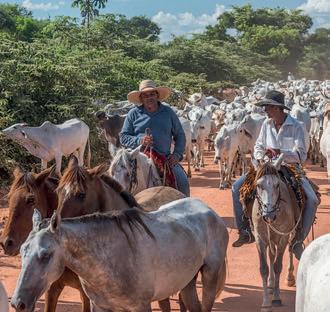
Opportunities for circularity
This remoteness is not part of Tapestry’s relationship with leather, Logan Duran argues. He talks of the accessories group as a finished product company that “leans into the intrinsic qualities of leather”, its durability, longevity and “the quality associated with it”. But Tapestry’s cold analysis of its own supply chain also shows leather to be its highest-volume and highest-impact material. It is this insight that led the group to try to take a strategic, long-term view of the consequences of its preference for putting leather into its products. It embarked on this with an eye always on what Mr Duran calls “the opportunities for circularity”.
Results of this work so far include taking to 99% the proportion of Tapestry leather in 2024 that came from tanneries rated gold or silver by multistakeholder body the Leather Working Group. In 2024, it mapped beyond tier two almost 75% of the raw materials it uses. One of its goals for 2025 is to achieve 95% traceability and mapping of these materials. One conclusion it has drawn, the vice-president for ESG and sustainability makes clear, is this: “The best thing we can do from an environmental perspective is to keep products in use for as long as possible.”
value for farmers who adopt traceability. It can be hard to convince them; a traceability project will mean work and investment for them.”
Benefits to farmers include using the technology to increase production efficiency. This will allow them to supply the necessary increase in beef more affordably (and, as mentioned, without using more land). In addition, Mr Bellese quotes United Nations figures that suggest raising two head of cattle per hectare instead of only one could reduce the emissions calculation for beef (and, by extension, for leather) by up to 70%.
Walk the walk
His conviction is that the fund can accelerate supply chain improvements and “send a signal to upstream partners” that performing well will be good for them. Clear signs that there is support for them and that there will be commitment to keeping that support going will help them. He thinks there is justified criticism that customers “in the most demanding markets” have appeared keen on raising the bar, on being strict about what they need from suppliers and on pointing the way forward. But they have appeared less willing to walk at least some of the road with those partners. Taking part in the Deforestation-Free Leather Fund will be one way of showing that their commitment to those suppliers is strong. And it is within this, he argues, that companies that make leather can use their “unique leverage” to accelerate change. This shows itself in the ability that leather companies have to maintain close connections with upstream suppliers, often helping them stay on top of the changing regulatory requirements. He insists this is true, in spite of leather makers having only a 1% share of the revenue that comes from the slaughterhouse. Their customers, brands and retailers, are often too far away from the world that the raw material emerges from, he suggests, making it hard for them to recognise which projects and initiatives can make the biggest difference.
Fernando Bellese knows the Deforestation-Free Leather Fund will not solve all of the issues in the livestock-beefleather value chain, but he thinks it can, at least, help the sector move in the right direction. “We want companies to commit for three years,” he concludes, “but we hope the fund will run for much longer. We hope it will run until deforestation is no longer a hot topic.”

According to WWF, the leather industry’s ties to cattle farming and meat and milk production are unbreakable.
Credit: Andre Dib/WWF-Brazil
“Leather is a by-product of the beef industry, but still carries responsibility for embedded impacts and emissions in the supply chain,” Fernando Bellese says.
Credit: Lineapelle


NTE Mimosa is the world’s best selling vegetable tannin. Produced from sustainablysourced, community grown black wattle in KwaZulu-Natal, South Africa, NTE Mimosa has been behind the world’s finest natural leather since 1920.
From the bark of the acacia mearnsii tree to the world’s most beautiful leather




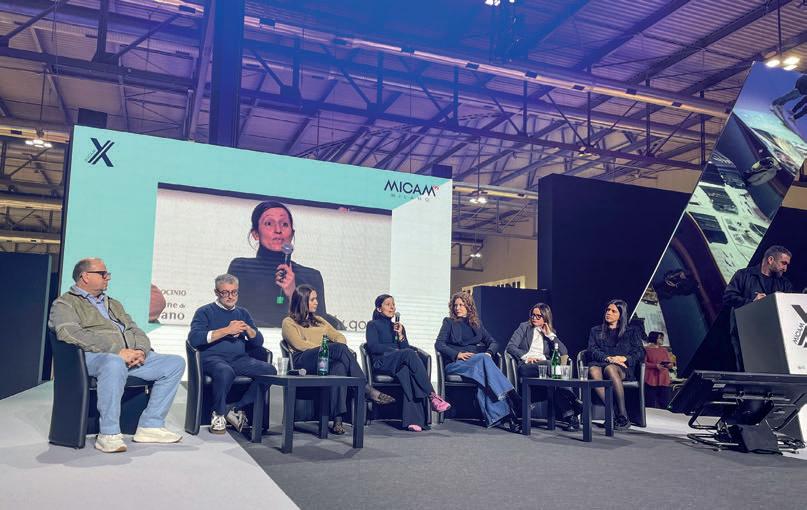
SMEs weigh data burden
The head of a small Italian footwear manufacturer inadvertently summed up the burden of new European data requirements by lamenting the “problem of sustainability”. Speaking as part of a panel discussion at footwear show Micam Milano, Alberto Masenadore of Calzaturificio Peron [politely] expressed frustration about the incoming legislation. “In the previous years, our main concern was to satisfy the designer, making good samples, and then satisfy the production, making high-quality shoes,” he commented. “Now, we have to also face this problem of sustainably.”
He is, of course, talking about the slew of new regulations and demands expected in the European Union in the next five years or so, including Digital Product Passports, Extended Producer Responsibility, the Corporate Sustainability Reporting Directive and others under the European Green Deal, which aim to make the fashion industry more sustainable and accountable, putting the onus on the sellers to take more responsibility for the goods they place on the market. As part of this, products will be expected to carry information about materials and manufacture, and the retailers must have a clear view of inputs and end of life. But who is expected to provide all this extra information? Whatever the theory, it looks like it will be the manufacturers, a challenge many – especially small- and medium-sized enterprises (SMEs) – are wholly ill-equipped for.
Some of the world’s most beautiful shoes are made by highly skilled artisans in small workshops. Now, these are being asked to also become data providers and sustainability managers as their customers lean on them to supply information for European legislation. What will become of these Italian SMEs that operate with already-tight margins?
There are about 4.3 million SMEs in Italy, 95% of which are micro-enterprises. They employ 13 million people and account for 80% of employment, according to government figures, generating more than 65% of the nation’s added value. They are the “powerhouse of the Italian economy” says Valentino Valentini, deputy minister at the Italian Ministry of Enterprises. However, there is now an urgent need to digitalise and upgrade these businesses so they can meet the fresh needs of their customers.
Alberto Masenadore and Rosie Gaunt speak as part of a panel on sustainability at Micam in Milan. Credit: WTP
“The question of who will bear these costs is complex and sensitive.”
GIOVANNA CEOLINI, ASSOCALZATURIFICI
“The new EU regulations, particularly the Digital Product Passport requirements under the Ecodesign for Sustainable Products Regulation, present several challenges for smalland medium-sized footwear manufacturers,” Giovanna Ceolini, president of Italian footwear manufacturers association Assocalzaturifici, tells World Leather. “SMEs will need to collect and document detailed data on materials, production processes, chemical usage and supply chain information, which they may not currently track systematically. Additionally, implementing digital systems to create, manage and transmit data requires technical expertise and software investments that small manufacturers often lack. Footwear production involves multiple suppliers across different countries, making full traceability a challenge for small producers with limited influence over their supply chains. Furthermore, validating environmental claims and material compositions may require laboratory testing, adding further costs.”
Brands united?
Brands share some of the frustration, according to Rosie Gaunt, head of responsibility at luxury shoe brand Manolo Blahnik. Although not speaking in an official capacity, she expresses how difficult it is to gather the data required for the new rules. “It’s coming to us in snippets, and it’s not good enough,” she says. “There are a lot of solutions but these need investments from the brand, unfortunately, so it’s a challenge to prioritise that investment to make that work easier.”
Speaking at Micam, she was keen to stress how lucky brands are to work with such skilled artisans, and admits they are now asking them to “wear so many hats”. “All brands are asking a similar supply base for the same information, but maybe in a slightly different way, so we’re inadvertently doubling, tripling or quadrupling the workloads of suppliers who are already doing something they haven’t been trained to do,” she says. “So, more collaboration is needed across the sector to support our suppliers, which is really what the whole industry is underpinned by.”
More collaboration, and more clarity, pleads Mr Masenadore. “We need a to work with our customers to find a way to get this data together, because, as everybody knows, the margins in production are very small. Crucially, we don’t have a clear picture of what they really need, and everybody is different. It is very important that this becomes clearer.”
Financial instruments
To help with the burden, the Italian government has introduced specific fiscal and financial instruments to help enterprises invest in digitalisation, as well as tax credits and state guarantees of 80% on lending for working capital and new investments. It has also established a network of 50 innovation centres that offer experimentation labs, targeted training and mentoring programmes for SMEs interested in adopting new technologies.
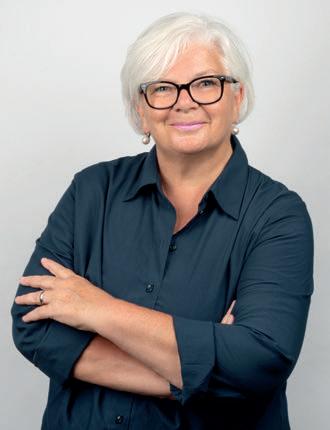
Specific to footwear, several approaches are emerging to help small manufacturers adapt, starting with the development of standardised models and specific guidelines, Ms Ceolini tells us. “A gradual adoption process is essential to allow less structured companies more time to adjust their systems. Also, accelerating digitalisation efforts will be key to facilitating compliance and reducing the burden on SMEs.”
For its part, Calzaturificio Peron has developed a system that uses radio-frequency identification (RFID) - adding a tag within the shoe that is able to carry data and record it in a permanent blockchain system. Footwear brand Tod’s recently used this system (although it is unclear whether it is from Peron) in its new My Gommino shoe, supported by the Aura Blockchain Consortium. Chips containing information on the origin of materials, production processes and compliance, as well as aspects of quality and sustainability, are embedded in the sole. Consumers can also scan this to learn stories of the artisans behind each pair, adding value by creating an emotional bond with the product.
These sorts of investments and strategies will be vital for the survival of the SMEs, and it is in nobody’s interests to let them flounder, but the question of who will bear these costs is “complex and sensitive”, Giovanna Ceolini concludes. “It will be necessary to work on brand-supplier dynamics with shared responsibility models and to be cautious about passing significant price increases on to end consumers. SMEs with less bargaining power may face greater pressure to absorb these costs.”
Giovanna Ceolini, president of Assocalzaturifici and Micam, understands the pressure small businesses will be under to comply with new rules.
Credit: Micam
Liberation Day blues
Trade was already hard enough in the post-pandemic and geopolitically tense environment of the mid-2020s. The trade disputes that began with tariffs that the US government put in place in early April and the countermeasures that its trading partners have scrambled to offer in reply, leading to a pause of 90 days in most cases, have only made matters worse.
President Donald Trump trailed new tariffs for most of the first quarter of 2025 before imposing a wide range of measures on an equally wide range of countries and industries on April 2. In the immediate build-up, he repeatedly referred to April 2 as Liberation Day because he was certain that payment of all the new tariffs would bring “large amounts of money” into US coffers to fund promised tax cuts and to redress the country’s trade deficits with major economies around the world.
He claimed Liberation Day would go down in history as the day on which industry in the US would be reborn. He said: “We will supercharge our domestic industrial base. We will pry open foreign markets and break down foreign trade barriers. More production at home will mean stronger competition and lower prices for consumers. For decades, our country has been looted by nations near and far. Foreign leaders have stolen our jobs. Foreign cheaters have ransacked our factories, and scavengers have torn apart our once-beautiful American dream.”
Part of the dream
Cattle, and by extension hides and leather, have been part of the American dream for the best part of two centuries. USbased meat companies generate around 600,000 cattle hides per week. Tanneries in key leather manufacturing countries in Asia and elsewhere turn those US hides into large

April 2025 was a cruel month of tariffs, counter-measures, trade tensions and uncertainty. It may mean the end for the model for making and shipping goods that has been in place for decades. This article, the first of two on this subject, considers what this means for hides and leather. The second article examines the implications for finished products that use leather.
volumes of finished leather. Finished product companies, many with their headquarters in the US, put that finished leather into shoes, car interiors, furniture and accessories for customers in all parts of the world.
Frequently, under the business model that has evolved, finished product brands work with partners in China, Vietnam, Indonesia, India, Bangladesh, Pakistan, Mexico, Italy, Portugal, Spain, France and many other countries to carry out the manufacture of their products. This global trading system has been in place for 80 years and has generated growth in global gross domestic product from $3 trillion in 1970, according to figures from the World Bank, to more than $100 trillion now. It may now be in danger of crumbling before our eyes.
The US cattle trade produces around 600,000 hides per week. Let them go to waste and they will cause 190,000 tonnes of CO2-equivalent in emissions each week. But in the right hands, cattle hides can generate more than 2000% in added value. Credit: Ann Marshall/US Department of Agriculture
Hide renewability
Few industries are as truly global, and, therefore, as firmly in the thrall of the global trading system, as leather. With shipments of raw material and finished leather already in need of a major boost, the extra headwinds and the concomitant increase in tensions, uncertainty and caution that Liberation Day is causing will be of no help to the industry.
Sometimes sellers can afford to be patient and wait for difficult market situations to settle down. In theory, this could apply to tanners now. If they have the cash-flow and the physical space to invest in raw material and store semiprocessed hides, they could keep part of the supply chain flowing. We saw a lot of that during the covid-19 years and, in many instances, inventory proved discouragingly slow to shift, making this an unappealing prospect now. Part of the rationale for many is that when the longed-for lift in demand for leather comes, there will still be plenty of hides available. This brings us to the second reason why new disruptions could be bad news for the industry. Hides are such a renewable resource that new stocks continue to become available no matter how much the demand for leather falters and no matter how much panic presidential executive orders spread. People’s need to eat is unchanging and the desire of billions to eat meat remains strong. Therefore, to satisfy that demand, farmers continue to raise cattle, and meat companies continue to buy the livestock and send it to slaughter, removing the hides at the abattoir. This is what makes leather so strongly in tune with the circular economy. What happens when the hides leave the abattoir matters immensely because, as we reported in World Leather OctoberNovember 2024, a failure to turn them into leather will have a startling environmental impact. One tonne of discarded hides will create 12.5 tonnes of CO2-equivalent in direct emissions, without taking into account emissions from the production of the non-leather materials that finished product manufacturers might choose to use instead. The Leather and Hide Council of America did the work to calculate these figures. It told us at the time that current estimated volumes of hides going to waste globally are already likely to be causing direct emissions of 40 million tonnes of CO2-equivalent per year.
Missed opportunities to create value from any hide rub economic salt on the environmental pain. When World Leather analysed figures from France a few years ago, we found that the French leather industry’s investment in raw materials in 2019 was about €665 million. The leather and leather products this material produced ended up creating value of €14.4 billion. The industry was able to increase the raw material’s value by almost 2200%. It is, therefore, difficult to see who can gain if trade tumult causes more hides to go unused and the existing waste to increase.
Ups and downs
On Liberation Day, measures the president announced included a baseline tariff of 10% on almost all imports into the US from almost all countries around the world. For some products, the rates are higher: a 25% tariff on all imported cars stubbornly stayed in place during early April’s rollercoaster ride of baffling daily changes to the figures. Similarly, there is a 25% tariff on imports of steel and aluminium.
For some trading partners, including many that are key players in the global hide and leather industry, the rates are higher still. Imports from China were, initially, to be subject to an additional blanket tariff of 34%, on top of the 20% levy

already in place, taking the total to 54%. In the wake of Liberation Day, China imposed additional 34% tariffs of its own on imports from the US. President Trump’s response was to increase, on April 8, total tariffs on imports from China to 104%. China then increased its counter-measures against US imports to 84% in total, at which point President Trump announced a rate of 125% for China, then 145%, with China retaliating with a 125% rate of its own. A full-scale trade war between the world’s two biggest economies had begun to rage.
As per the Liberation Day announcement, imports from Cambodia will be 49%, while Vietnam will incur tariffs of 46%.
Elsewhere in Asia, the figures for Bangladesh, Thailand, Taiwan, Indonesia, Pakistan, India, South Korea and Japan are, respectively: 37%, 36%, 32%, 32%, 29%, 26%, 25% and 24%. The European Union faces blanket tariff rates of 20% on most of its exports to the US (cars, as mentioned, are an important exception). The rate is higher for Switzerland at 31%.
After a week, on April 9, President Trump announced a 90day pause on most of these higher tariffs to allow trading partners to negotiate new deals with the US. While these negotiations take place, most imports from most countries will be subject to the baseline tariff rate of 10%. China misses out and keeps its 125%. The president said China also wants to “do a deal” with the US, but “just doesn’t quite know how to go about it”.
Probable hide price hikes
These measures still spell trouble for US hide exports, especially those that, for years, have been going to China. This, and all the confusion, will push prices up and heated
US president, Donald Trump, presented new tariff rates to the world on April 2, which he called Liberation Day.
Credit: The White House
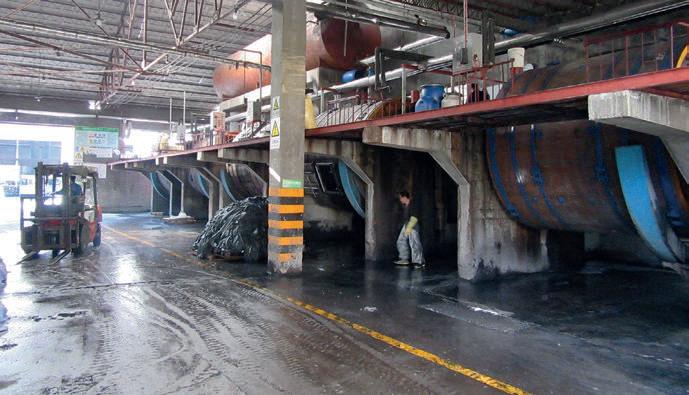
debates over which party picks up the extra cost are unlikely to lift the mood much. US hides remain in demand, although volumes have gone down in the last few years as the national cattle herd goes through a period of adjustment. These exports have brought in less money because of the lower volume and because hide prices have been very cheap for a considerable time, but they are still worth more than $1 billion per year to the US.
Between January and October 2024, China imported nearly 12.4 million wet-salted hides from the US, two-thirds of the country’s total exports of this raw material. For exports from the US of wet blue, the four biggest buyers were Vietnam, China, the European Union, followed by Thailand. Together, tanners in these markets snapped up just over 3 million US wet blue hides during the ten-month period, almost 90% of the total.
The average price for wet-salted across the ten-month period was $29.28. The average price for US wet blue was $99.05. If, for argument’s sake, these prices stay the same, China’s 125% tariff on imports from the US would push wetsalted prices to $65.88 each. And, with the tariff included, wet blue hides shipped from the US to China would cost $222.86 each. These are significant price hikes and it seems clear that it will probably be easier for China to find new sources of raw material than it will be for the US to find new buyers for its hides. In the end, the hides have to go to where the tanning drums turn.
Emissions risk
The fact remains that, throughout all of this, the material will continue to be available. If there are 600,000 US hides available per week, we can divide them 50-50 between steers and heifers or cows. We know female cattle slaughter levels have had a higher share for a few years as the national herd contracts, but for simplicity’s sake, we can call it even.
We can also say, from figures that the US Department of Agriculture publishes, that the average weight of steer hides coming to market at the moment is around 28.5 kilos, while the figure for cow and heifer hides is 23.2. The midpoint is, therefore, a weight of around 25 kilos. Total US hide volumes for one week weigh 15,000 tonnes. If, heaven forfend, the hides should go to waste, Liberation Day would lead to direct emissions from unused cattle hides of almost 190,000 tonnes of CO2-equivalent per week.
Commodity considerations
“That would be unthinkable, but it is not going to happen,” observes the vice-president of operations at Bank Bros & Son, Dr Barry Bank. “The hides will still move, even with China adding its counter-veiling tariffs to the cost of importing them. The hides will sell, but the price the US receives will come down to compensate for the tariffs. Hides are a commodity and, for commodities, price is always the remedy.”
Implications of Liberation Day for Canada have generated abundant commentary there. The leather and hide trade have barely merited a mention, which is no surprise to Dr Bank. His family’s Toronto-based company is one of the last remaining players in the Canadian industry. Its involvement in tanning is now exclusively on the US side of the border; Pennsylvaniabased Wickett & Craig is part of the group. But it still sources and exports Canadian hides.
Officials at Agriculture and Agri-Food Canada have told World Leather that, in 2024, Canada shipped a total of 3.1 million cattle hides and calfskins to 17 markets overseas, earning export revenues of 140 million Canadian dollars. Tanners in China were the biggest buyers, and only 2.9% of the total volume went to the US. This is a small number of hides to redirect, should the trade tensions make that necessary. This is because too few tanners remain on US soil to make it an important market for Canadian hides.
US wet blue hides being processed at a tannery in Asia. Vietnam, China, the European Union and Thailand bought almost 90% of total US wet blue exports in the first ten months of 2024.
Credit: WTP
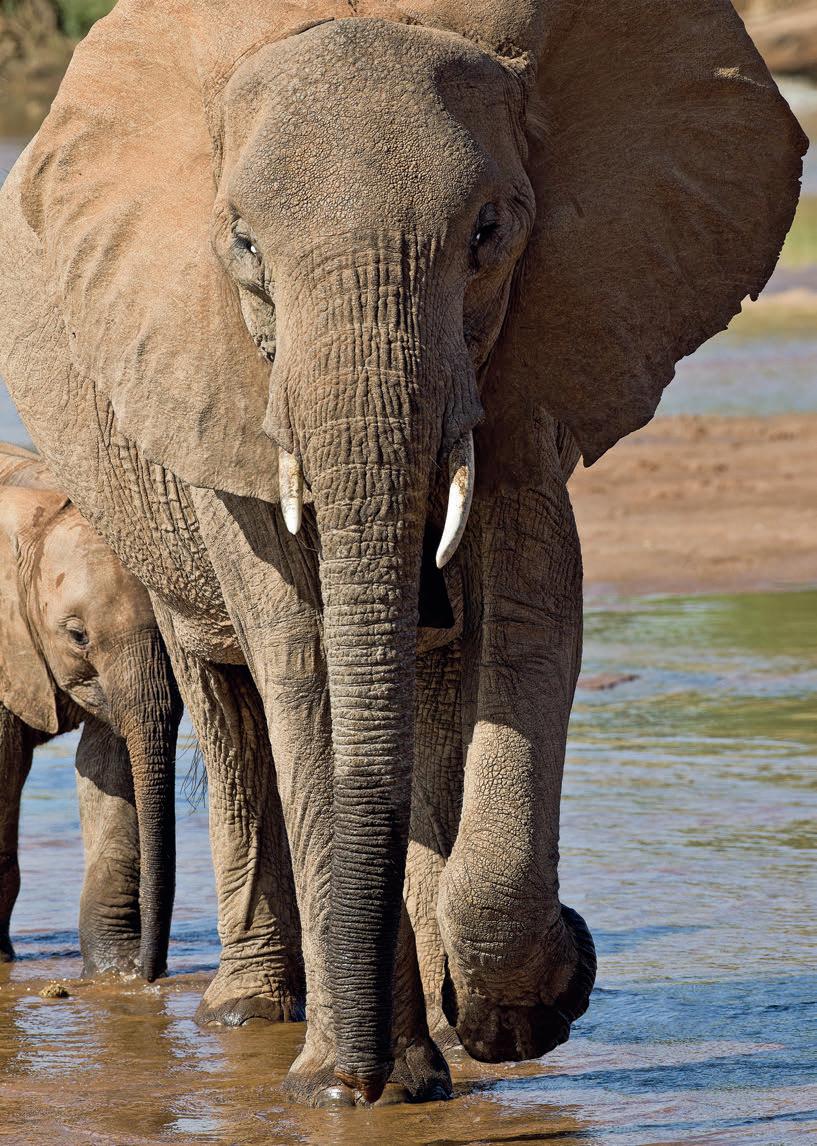
Ph. Gianni Maitan
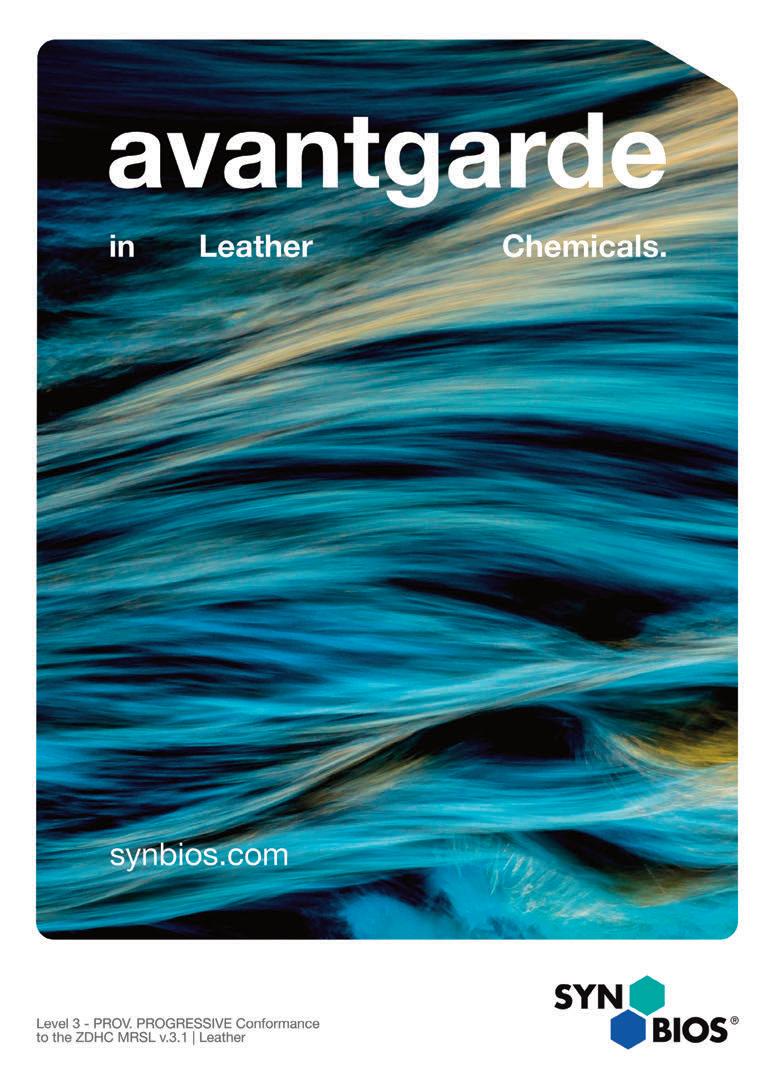
“What happened to tanners here in Canada has largely happened in the US too,” Dr Bank says. “The shoe leather tanneries are long gone and in the last few decades, the automotive tanners have all decamped to Mexico. Some vegetable-tanned production remains, but we only have three remaining customers of any magnitude in the US, including our own Wickett & Craig tannery, and the volumes are still small. That’s why shipments of hides from Canada to the US are tiny, and those hides that we do ship to the US at the moment will sell elsewhere, immediately.”
He insists that Canadian cattle hides are of high quality and are in demand in China, Japan, Mexico and other markets. “They will always sell,” he says. “It is just a matter of price and, to be frank, the US is not even the highest payer for our products. We will not be penalised by these tariffs.”
Beef grief
Australia, Argentina and the UK are among the trading partners who emerged from Liberation Day with their exports to the US mostly incurring only the baseline tariff of 10%. Some business leaders and politicians in these countries hoped they would get off even more lightly. Leather and hides do not feature in the explanations President Trump and The White House offered for imposing 10% tariffs on these allies and friends, but beef does. A factsheet that the White House shared with reporters at the time of the April 2 announcement made specific reference to beef and to trading partners’ positions on beef that the US regards as unfair.
It said that the UK maintains “non-science-based standards that severely restrict US exports of safe, high-quality beef”. The same fact-sheet said Argentina has banned imports of US live cattle since 2002 owing to “unsubstantiated concerns regarding bovine spongiform encephalopathy”. It added that the US now has a $223 million trade deficit with Argentina in beef and beef products.
Still specific to beef, President Trump said on making the April 2 announcement that this was one of the reasons for including Australia among the countries facing new tariffs. He said: “Australians are wonderful people, but they ban American beef. They won’t take any of our beef, yet we imported $3 billion of Australian beef last year alone.”
Calm among the neighbours
For Canada, as we have seen, and also for Mexico, the situation is complex, which is ironic because these two neighbouring countries have had free-trade agreements with the US since 1994. A number of products will still enjoy freetrade status when moving from one North American country to another, but many will not. Exports to the US of commodities relating to energy will face tariffs of 10%. Many other exports will incur tariffs of 25%.
Donald Trump appears not to be the most enthusiastic supporter of the first North American Free Trade Agreement (NAFTA), which took effect in 1994. Since then, he has said, more than 90,000 factories in the US have closed and the country has lost five million manufacturing jobs. “That was the worst trade deal ever made,” the president has commented. NAFTA’s successor, USMCA, came into effect in 2020. As things stand, hides from Canada, the US and Mexico seem to be among the products that can continue move under USMCA.

If this changes, Mexico could still source hides directly from Canada under the agreement. Mexican tanneries only bought 87,000 cattle hides from Canada in the whole of 2024, according to the Agriculture and Agri-Food Canada figures. But the distant days of 2024 were a time when, thanks to USMCA, a huge volume of US hides were crossing the southern border every week to supply leather manufacturers in Guanajuato and other parts of Mexico. Barry Bank estimates that figure to be around 200,000 hides per week, around one-third of the total volume available from US abattoirs. Canada cannot make up for the loss of that volume, but it can contribute more than 87,000. It can even ship the material on US roads and rivers; the hides can travel as bonded freight without any penalty, Dr Bank explains.
On the Mexican side of the border, the discussion quickly took a surprisingly upbeat tone. Because there are such big questions over what new pattern will emerge for trade flows from Asia to the US, many Mexican commentators believe manufacturers there can increase their already large share of the US market.
Mexico’s president, Claudia Sheinbaum, has said she continues to believe in dialogue and that talks with the trade authorities in the US over making their relationship even better are ongoing. She is also in dialogue with important manufacturing companies in Mexico, including those in the hugely important automotive sector. Automotive companies employ close to two million Mexican workers and the industry brought in almost $200 billion in exports in 2024. “They have told me that, for now, they have no intention of making any changes to the way things work here,” she says.
Mexico’s president, Claudia Sheinbaum, addressing a public meeting in the capital in March to address concerns about US tariffs.
Credit: Gobierno de México
Volkswagen opened this assembly plant in Chattanooga, Tennessee, in 2011. It employs 5,500 people. Globalisation of the automotive supply chain has helped the US keep car factories open.
Credit: Volkswagen AG

Bad for goods
Dreams of a quick calming of the storm after the US’s tariff announcements in early April seemed unlikely in the frantic first week of the month. Then, for many, calm came on April 9. Most of the new tariffs US president, Donald Trump, announced on April 2 came into effect within a few days. There was a baseline rate of 10% for almost all products coming into the US from overseas. For imported cars, aluminium and steel, there were tariffs of 25%.
Then there were escalating rates for places that President Trump said had taken the greatest advantage of previous, lenient trading regimes to rip of the US. Many of the biggest producers of leather and finished products that contain leather were on this list. There were tariffs of 46% for Vietnam, 37% for Bangladesh, 36% for Thailand, 32% for Taiwan and Indonesia, 31% for Switzerland, 29% for Pakistan, 26% for India, 25% for South Korea, 24% for Japan and 20% for the European Union.
Then, on April 9, there was a reprieve of sorts for most trading partners (but with one very notable exception). After a week of panic in government offices and on stock markets around the world, President Trump said he was pressing pause on these high levels for 90 days. He explained that this was to allow negotiations to take place on individual deals between the US and its partners, during which time their exports to the US will be subject to the 10% baseline rate.
Imported cars will still face 25% tariffs. Many products crossing the US’s northern border with Canada and its southern border with Mexico will also face 25% tariffs.
This second article on the 2025 trade crisis focuses on finished product and shows that companies and consumers everywhere, including the US, will feel pain.
China crisis
Even among these other exceptions, China is a case apart. China was among the countries that put in place countermeasures following the announcement on April 2, which President Trump had called Liberation Day. The US had imposed an additional tariff of 34% on imports from China, so the Asian country made a similar move, adding 34% to tariffs already in place on products from the US. This sparked further White House reaction and the US said on April 8 that total new tariff levels for China would be 104%. China came back the following day with a total figure of 84% for imports into China from the US. Later that day, the 90-day pause announcement came. But while, for the time being, most other tariffs have gone down, China’s went up, reaching 125%, then 145%. China responded with levels of 125% for imports from the US. As we illustrate in a separate article in
this issue of World Leather, millions of US cattle hides for the Asian country’s tanneries are among the products caught up in this. Our focus in this second article is more on the billions of dollars’ worth of cars, shoes, bags, furniture and other finished products that flow into US ports, shops and homes from overseas factories.
Roll-back of globalisation
While all this was going on, stock markets everywhere registered huge fluctuations, rallying on the 90-day news, but initially suffering heavy falls. The immediate aftermath of Liberation Day was a situation that the Financial Times described as a deepening “global rout”. In another article, it said the markets were reacting to “an aggressive push to roll back globalisation”. Mr Trump, it said, seems intent on unwinding decades of economic integration, with the risk of a 1930s-style global trade war causing the markets to panic.
The FT”s chief economics commentator, Martin Wolf, has said the US’s imposition of a new baseline tariff of 10% on almost all imports, with the steeper rates for many still looming, “injected massive uncertainty into the world economy”. He points out that this has made it difficult for companies to plan and make long-term decisions.
Speaking on BBC radio, Mr Wolf said: “We don’t know where Donald Trump’s policies are going to go. My guess is that, at the end of this, tariffs will remain much higher than they have been for close to 100 years.”
The author of an influential book called Why Globalisation Works, Martin Wolf says he fears the effects of Liberation Day will be long-lasting. He says, too, that it is trade in physical goods, which, naturally, include hides, skins, leather and finished products made from leather, that will bear the brunt of the turmoil.
Economic disintegration
“Crucially, tariffs only really affect goods,” Mr Wolf says. “They don’t have much effect on services. It is very difficult for me to imagine that [the impact of Liberation Day] is going to be temporary. This means the disintegration of the ‘goods’ part of our economies.”
He explains that this disintegration had already begun, at the time of the 2008-2009 financial crisis, and adds that this new crisis is likely to accelerate the decline.
He argues that globalisation, with a huge proportion of manufacturing activity moving from the most developed economies to developing parts of the world, has been “unambiguously good”, especially for countries in Asia. He says that, thanks to globalisation, extreme poverty in most of those countries has been “more or less eliminated”.
With the US receiving only 14% of the world’s imports, Mr Wolf also suggests that one outcome might be that the rest of the world continues to keep, and even improve, globalisation and the established multi-lateral trade system. It will probably be some time before we know if this can become reality, but even if it can, the immediate future looks to be bad for goods.
Car commotion
US economics editor of The Economist, Simon Rabinovich, argues that the early effects of all the rhetoric have included a slowing of the US economy, with consumer confidence falling to its lowest level in 12 years and wider business uncertainty “off the charts”. As mentioned, the markets went
“Tariffs only really affect goods; this means the disintegration of the ‘goods’ part of our economies.”
MARTIN WOLF, THE FINANCIAL TIMES
back up sharply after news of the 90-day reprieve became public, but doubts remain over how high the tariff rates will go in the end and which products will suffer the most. This is leading many companies to go into “a state of paralysis”, Mr Rabinovich says, with businesses “sitting on their hands, waiting to see what the landscape is actually going to look like”. He points to indecies that show trade-related uncertainty to be at its highest in more than half a century.
As we have seen, the automotive industry was an immediate target for tariffs. The original announcement of the 25% levy on overseas-made cars came one week before Liberation Day (which, incidentally, The Economist renamed ‘Ruination Day’). This will have a dramatic effect on the global automotive industry, Mr Rabinovich says. “The auto industry, everywhere in the world, is an integrated industry that relies on cross-border trade,” he explains. This includes the US industry, too, which is “tightly woven in” with production networks in other parts of North America. A new car might be finished in a factory in the US, but before that happens, he says, the different parts and materials that go into the product might have crossed the borders with Canada and Mexico seven or eight times.
This complex-sounding practice came about because Mexico and Canada share a free-trade agreement with the US and have done since 1994. In keeping with this, even now the White House is saying it will only apply the 25% tariffs to non-US content in the cars that continue to cross the border. But this question of identifying what is and what is not US content is complex in itself. Leather in the seats for a car’s interior is likely to have come from one of Mexico’s tanneries. But the raw material the tanners used is likely to have been US hides.
According to Simon Rabinovich, the 25% automotive tariff might be bad news for exporters in Germany, South Korea and Japan, as well as for suppliers in Mexico and Canada but, ultimately, it will be bad for the US car industry too. “Donald Trump believes that these measures will bring investment in auto factories in the US,” he concludes. “And over time he may be right because the 25% tariff is really onerous. Nevertheless, you are going to end up with a highly protected, highly uncompetitive, domestic auto industry that produces inferior vehicles at higher prices that the US is not going to be able to export to the rest of the world. This is not a recipe for success, in the short term or the long term.”
Turmoil unfolds
The automotive exporters in Germany and elsewhere that he mentions have watched in horror as the tariff turmoil unfolds. Industry organisation VDA has said the new tariff regime marks “a fundamental turning point in trade policy” for the entire industry. VDA president, Hildegard Müller, says the steps the US has taken since the start of April to control imports of cars represent a departure from the rules-based global trading order and from “the foundation for valuecreation, growth and prosperity in many regions of the world”. She insists that the measures the US has announced will be “a
A shoe from New Balance’s Made In USA collection for spring-summer 2025. Brands and manufacturers made around 25 million pairs of shoes in the US last year. The volume of footwear that US companies imported from China in 2024 was 50 times more than that.
Credit: New Balance

massive burden and challenge for companies, and for the global supply chains of the automotive industry”. But she also points out an irony. As a result of this globalisation of supply chains, the German automotive industry employs around 138,000 people at more than 2,000 locations in the US. Japanese and Korean companies also have car plants on US soil.
Footwear fears
Shoes have also featured prominently in the post-Liberation Day commentary. As in automotive, the US does, after all, still have footwear factories and produced around 25 million pairs in 2024, according to industry body Footwear Distributors and Retailers of America. But shipments of shoes from China to the US reached almost 1.25 billion pairs in the same year, about 50 times the volume of domestic shoe production. Footwear manufacturing in the US could expand, but if the trade dispute continues it is difficult to imagine how it could quickly expand by 50 times. And much of the raw materials manufacturers use, including leather, would need to be imported from somewhere else, including China.
According to a senior figure in the global footwear industry, William Wong, the first instinct of at least some US brands was to look for new overseas producing countries to outsource from. He received a spate of calls about this from brands following the tariff announcements of April 2. Hong Kong-based Mr Wong, who is president of the Global Footwear Sustainability Summit and a consultant to the Hong Kong Footwear Association, told the Wall Street Journal that callers want to know where they can turn to in order to avoid the heaviest blows that the new tariff regime will deliver to footwear.
He mentioned the Philippines and African countries as places brands are interested in. But he said Asian outsource footwear manufacturers are reluctant to invest in new operations there. He explains that it would take years to build up a big enough production base in these countries to meet the needs of US brands. Setting up a large-scale manufacturing business is “not like switching on or off the lights”, Mr Wong says.
Special consideration
Industry body the Leather and Hide Council of America (LHCA) has worked hard to help find other ways of mitigating the high tariffs importers of leather products will face. It lobbied for and has managed to secure an “accommodation”, an acceptance that imports containing material that originated in the US can receive a special consideration.
“What that means,” LHCA says, “is that leather products containing more than 20% US hides or skins by value would be eligible for a tax exemption.” It is still working with the US customs authorities “to understand and confirm the process and documentation requirements” for imported leather articles to qualify for the exemption. Implementation of this will, unfortunately, be difficult.
If 20% of the value of an imported pair of shoes, for example, is from leather made from a hide from the US, those shoes could be imported into the US with a 20% discount on any tariff payable. However, because hide prices have been low for many years, it is difficult to see how imported leather footwear could be cheap enough for the leather to represent 20% of the total value.
From the most recent figures we have seen from LHCA, US wet-salted hides had an average export value of $29.28 in the first ten months of 2024. Calculations World Leather has done in the past suggest the leather content in one pair of athletic shoes is about 2.5 square-feet. This gives us a rule-ofthumb. The grain side of one US hide will yield 50 square-feet of finished leather. This will make around 20 pairs of shoes.
A pair of shoes made from leather from US wet-salted hides would have US originating content worth around $1.50. For that shoe to earn some post-Liberation Day relief, the value of the product on being imported into the US would need to be $7.50 at most. Run the same calculation with wet blue exported from the US and the imported shoes could only qualify if their value were around $24.50 at most, taking only grain leather into account.
LHCA says it is aware that the April 2 announcement, and the imposition on the US of reciprocal tariffs by other countries, notably China, will bring challenges to its
member companies and their overseas trading partners. “We are working tirelessly with our foreign association counterparts and the US government to encourage a way forward to minimise the impact on the global leather industry,” LHCA says.
Bags of trouble
Luxury leathergoods groups in Europe will have breathed a collective sigh of relief on learning, on April 9, of the 90-day pause on President Trump’s tariff of 20% on imports from the European Union to the US, halving the rates, at least for three months. The lower tariff is good news for LVMH, Kering, Hermès, Chanel and others because there is no doubting the importance of the US market to this sector.
LVMH reported full-year revenues of €84.7 billion for 2024, with €41 billion coming from its leathergoods and fashion division. It said 25% of revenues overall and 17% of its sales revenues in leathergoods and fashion had come from the US. Across all of its brands, LVMH had almost 1,200 stores in the US at the end of the year, stocking mostly products imported from France, Italy, Spain and other parts of Europe.
At Kering, the full-year revenue figure for 2024 was €17.2 billion. Grouping all of North America together, it said 24% of its revenues last year came from that market. Growth at Hermès took its results for 2024 to revenues of €15.2 billion. It gave a figure of more than €2.8 billion for the whole of the Americas, 18.4% of the total.
It is usually late May these days before Chanel reports its annual results, so 2024 figures are not available yet. In 2023, the group achieved revenues of $19.7 billion. It, too, reports the Americas as a whole, attributing just under $4 billion of its revenues in 2023 to sales in this market, 20% of the total.
Making some adjustments for the different currencies and geographies involved in these groups’ reports, we can make an educated guess at combined revenues of around €30 billion in the US. At a 10% tariff rate, imports from these four groups alone would contribute around €3 billion per year to US government coffers. If the tariff rate were to go back to 20%, the figure would be €6 billion.


Credit: Sarah Wells Bags
Lack of support
There are bag brands on the other side of the Atlantic, some of them big. But smaller ones in particular (of which there are many in the US) are now under severe strain, if the reaction of Sarah Wells is anything to go by. Ms Wells used to be the executive director of a national non-profit organisation in Washington DC. Returning to work after maternity leave in 2015, she searched high and low for a stylish bag in which to carry around equipment she needed to express and store milk. Finding no bag that she liked enough, she designed her own and soon found herself giving up her job and launching Virginia-based Sarah Wells Bags. Some of her bags have leather, particularly in the straps. All of them are made in China and imported back into the US from there.
She says that the tariff impact on these imports of the chaotic, early-April tariff tit-for-tat was already close to 100%, according to her calculations. This was before the later escalations. She explains that she would never be able to add this to her product prices to claw back enough margin to sustain her business. “And I don’t have the cash to come up with $100,000 to release goods at the port,” she says of product that was already on the ocean. If tariff rates stay this high, she is sure many business with a similar model to hers will close.
Credit: Shutterstock/Andersphoto
She adds that she would love to make the bags in the US, but says the infrastructure, resources and support she would need are lacking. Even if there were the factory capacity at least to assemble the finished products, she has calculated that she would still have to import materials and components from suppliers in 14 different countries. All 14 are now subject to tariffs. Perhaps the necessary footprint can build up again in the US, but Ms Wells says it would take a number of years of paying costly tariffs for her still to be around to reap the benefit of this reindustrialisation. She doesn’t think she can do it.
Virginia-based entrepreneur Sarah Wells does not think she will be able to pay the tariffs on the bags she brings into the US from China.
A Chanel store in New York. On their own, four major European leathergoods groups have combined sales of around €30 billion per year in the US.
Fast fashion notions of durability are at odds with the European Commission’s Green Deal strategy.
Credit: Shutterstock/Surachai Jameet

Fast-fashion thinking damages durability debate
The leather industry’s main representative body in the European Union, COTANCE, has withdrawn from a group that is working on product environmental footprint category rules (PEFCR) for footwear.
For some time now, COTANCE has been an active member of the technical secretariat that is working to establish category rules for calculating the environmental impact of footwear and apparel products. As part of the group, COTANCE argued that the technical secretariat’s proposed parameters for describing footwear products as durable were far too lax and that this was to the detriment of the leather industry.
Suggestions are that the technical secretariat is seeking to present as “long-lasting” any shoe that can withstand just 100 wears. This has caused alarm in the leather footwear sector because leather shoes are often made to last for thousands of wears. These shoes’ genuine longevity is an important factor in convincing consumers that it is worth paying extra for leather. Leather shoes cost more up front, but if you keep them and wear them for years, they are much better value for money, and far better for the environment in the long run.
A group that has led lengthy discussions on what constitutes product durability has chosen to ignore fact-based arguments that favour leather and other natural materials.
Tests to pass
Less than two years ago, then European Commission vicepresident for the environment, Virginijus Sinkevičius, told the Global Fashion Summit in Copenhagen: “Waste generation is growing, fuelled by fast fashion. The average European consumes 12 kilos of clothing and footwear per year. A quarter of that gets exported after use. Most of the rest ends up in landfills or incineration.” He said the Commission wants to have “minimum requirements” for products sold in the EU market, with footwear one of the priority categories. “The key tests to pass are durability, reusability, and repairability,” Mr
“We cannot stand behind a methodology that promotes fast fashion over long-lasting quality.”
GUSTAVO GONZÁLEZ-QUIJANO, COTANCE
Sinkevi č ius continued. Passing these tests is all about encouraging recyclability, closing the loop and preventing the release of microplastics, he insisted, and, crucially, going “from fast fashion to a more long-term, sustainable relationship” with the products we buy and use.
Now COTANCE has said that, despite its efforts to present fact-based arguments in favour taking truly long-lasting materials into consideration as a means of building these sustainable relationships, the technical secretariat has refused to alter its position. As a result, COTANCE, which worked on this with “a global coalition of natural material stakeholders”, has formally announced its withdrawal from the group.
Wholly inadequate
The apparel and footwear PEFCR is now almost certain to include wholly inadequate durability values. “They disproportionately impact slow-fashion products made with natural material such as leather, wool, and cotton,” COTANCE says, “ultimately encouraging brands to deselect these in favour of less sustainable alternatives.” It has also asked for there to be no reference to COTANCE or its representatives on the updated PEFCR documentation so that no one viewing the written material will think there is support from the European leather industry for a methodology it does not endorse.
Secretary-general, Gustavo Gonzalez-Quijano, says COTANCE joined the process in good faith to help build “a fair and science-based environmental framework for fashion”. He adds: “Instead, we’ve witnessed a system that punishes durable, natural materials like leather, exactly the kind of products the circular economy should be encouraging. We cannot stand behind a methodology that promotes fast fashion over long-lasting quality.”
Make the link
Work to establish PEF category rules for footwear and apparel in the European Union started in 2019. The new technical secretariat began its work the following year. COTANCE was an ideal organisation to involve in the group because it had already worked on PEFCR for leather. This took many hours of effort over the period spanning 2013 to 2018, before securing official support from the European Commission for the new rules for calculating the carbon footprint of leather.
A first public consultation on how best to define the rules for calculating the environmental footprint of finished fashion products such as footwear and apparel began in 2021, attracting almost 1,000 comments. Tests to see how some of the technical secretariat’s ideas would work on real products in the real world followed. As far as footwear is concerned, these products included boots as well as open-toed and closed-toe shoes.
The secretariat said early on that it would not seek to
address Mr Sinkevi č ius’s concerns about microplastics, explaining that the methodologies to assess microplastic pollution and plastic leakage “are still under development”. But, at least on paper, it did make durability one of its priorities. “Durability is key to extending the life of apparel and footwear products and thus improving their environmental impacts,” it said. It added that it was taking into account the properties of different materials, for example the abrasion of footwear soles. It also said repairability was important to it, saying that making products easy to repair “promotes reusability and eco-design practices”. But it has not made the link between leather and these two critical characteristics.
Gustavo González-Quijano says COTANCE remains committed to dialogue and hopes still to convince the European Commission to take a more serious stance on durability in forthcoming formal reviews of the PEFCR.
The link between using leather in footwear and making it long-lasting and repairable is a disappointing omission from the technical secretariat’s work on PEFCR.
Credit: Micam


World Leather
The world’s leading magazine for the leather industry.
(6 issues per year)
UK: £90.00
Airmail: £150

Footwearbiz
All you need to know to assist you in the global footwear market.
(4 issues per year)
UK: £90.00
Airmail: £150

Sportstextiles
The international technical trade magazine for innovative and responsible materials.
(4 issues per year)
UK: £90.00
Airmail: £150
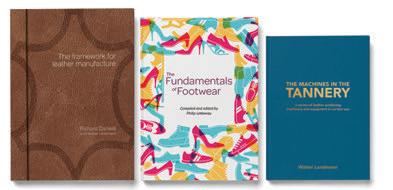

Inside Denim
Keep up to date with denim developments from raw material to finished product with in-depth coverage of advances at fibre and fabric level.
(2 issues per year)

Advertiser’s Index
Head Office
The Old Stone House, Teeton, Northampton NN6 8LH, UK Tel: +44 151 928 9288 E-mail: wl@worldtrades.co.uk
Editor Stephen Tierney
Deputy Editor Clare Grainger
Commercial Manager /Technical Editor Matthew Abbott
Consultant Editor David Buirski
Graphic Designer Tim Button
Subscriptions John Collins
Administration Lisa Fabian-Smith
Publisher & CEO Simon Yarwood


Worldwide Sales Offices
India:
S Sankaran, 106 Vepery High Road, Periamet, Madras 600 003 Tel: 91 44 25386566 Fax: 91 44 28343685
E-mail: indianleather@yahoo.com
Indonesia:
Niran Raphi BSc., Gedung Cahaya Palmerah 3rd fl, #307 Jl.Palmerah Utara III No.9 Jakarta Barat 11480 Indonesia Tel: +62 021 5329343 / 5329014 Fax: +62 021 5329344
E-mail: esdekatraco@centrin.net.id
Pakistan:
Abdul Rab Siddiqi, Office M – 2, DADA Garden, Jamaluddin Afghani Road, Sharfabad, Karachi 74800 Tel: 021-34893095 Mobile: 0333-2323166 Email: arsidiqi@yahoo.com
